At the Climate Action Summit held April 8 at Rose Hill, several elected officials were on hand to celebrate Fordham’s new role as an EPA grantmaker. U.S. Senate Majority Leader Chuck Schumer told the crowd, “We couldn’t have thought of a better place than Fordham” to dispense the federal funding, which will go to grassroots groups focused on climate justice.
Answering a call from Pope Francis, Fordham is indeed a place committed to taking “concrete actions in the care of our common home.”
Here are some updates from the first quarter of 2024, from student sustainability interns to “cool” foods to fun community events that make an impact.
Facilities
In January, 11 more undergraduate students joined Fordham’s Office of Facilities Management as sustainability interns to help the University in its efforts to reduce its carbon emissions. They’re working on projects connected to AI-enabled energy systems, non-tree-based substitutes for paper, and composting. The office is still looking for three more students to join; email Vincent Burke at [email protected] for more information.
Dining
Stroll into a dining facility at the Rose Hill or Lincoln Center campus, and you’ll find “Cool Food” dishes such as crispy chicken summer salad, California taco salad, and spicy shrimp and penne.
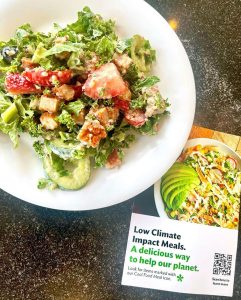
The dishes, which are marked by a distinctive green icon at the serving station, have a higher percentage of vegetables, legumes, and grains, which generally have a lower carbon footprint than those with beef, lamb, and dairy. According to the World Resources Institute—which Fordham partnered with on the Cool Food project—more than one-quarter of the world’s greenhouse emissions come from food production.
In March, the University went one step further by signing onto the New York City Mayor’s Office Plant-Powered Carbon Challenge. The pledge commits Fordham and Aramark to reduce our food-supply carbon emissions by a minimum of 25% by the year 2030.
Academics
This semester, a new one-credit, university-wide experiential learning seminar titled Common Home: Introduction to Sustainability and Environmental Justice was taught by faculty and staff from the Gabelli School, the Center for Community Engaged Learning, the Department of Facilities, the Department of Biology, and the Department of Theology.
Other sustainability-focused courses this semester include the City and Climate Change, the Physics of Climate Change, and You Are What You Eat: the Anthropology of Food (Arts and Sciences); Sustainable Reporting and Sustainable Fashion (Gabelli School of Business); and Energy Law and Climate Change Law and Policy (Law).
Students Take the Lead
At Fordham Law School, the student-run Environmental Law Review hosted a March 14 symposium that considered the impact of artificial intelligence on environmental law. Panels focused on how regulators and litigators can use AI and the challenge of addressing AI-generated climate misinformation.
In January, Fordham Law student Rachel Arone wrote The EPA Rejected Stricter Regulations for Factory Farm Water Pollution: What This Means, Where Things Stand, and What You Can Do for the Environmental Law Review. And the Law School’s student-faculty-staff collective Climate Law Equity Sustainability Initiative held a series of lunchtime discussions about climate change, law, and policy.
Student groups LC Environmental Club and Fashion for Philanthropy teamed up on March 8 to create reusable tote bags on International Women’s Day. The bags were donated to Womankind, which works with survivors of domestic/sexual violence and trafficking.
The United Student Government Sustainability Committee continues to run the Fordham Flea, a student-run thrift shop that connects students interested in selling old clothes with those looking to buy sustainably. The next flea will take place on April 26 from 11 a.m. to 2 p.m. outside of the McShane Center.
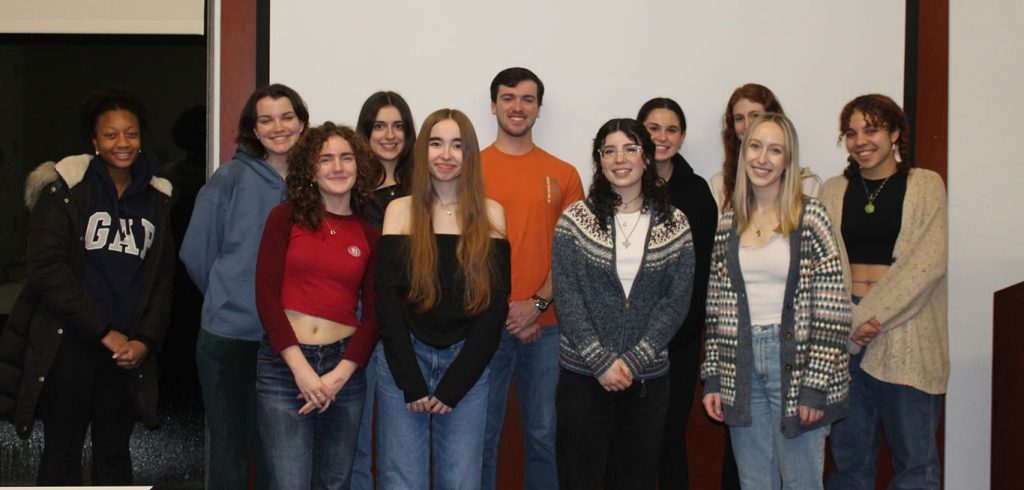
Community Engagement
The Center for Community Engaged Learning (CCEL) held an Urban Agriculture and Food Security Roundtable on Feb. 2. The gathering brought together community organizations and leaders from the Bronx to discuss urban agriculture and food security. Attended by Bronx Congressman Ritchie Torres, the meeting was also an opportunity for groups to learn about resources available from the USDA and the New York City Mayor’s Office on Urban Agriculture.
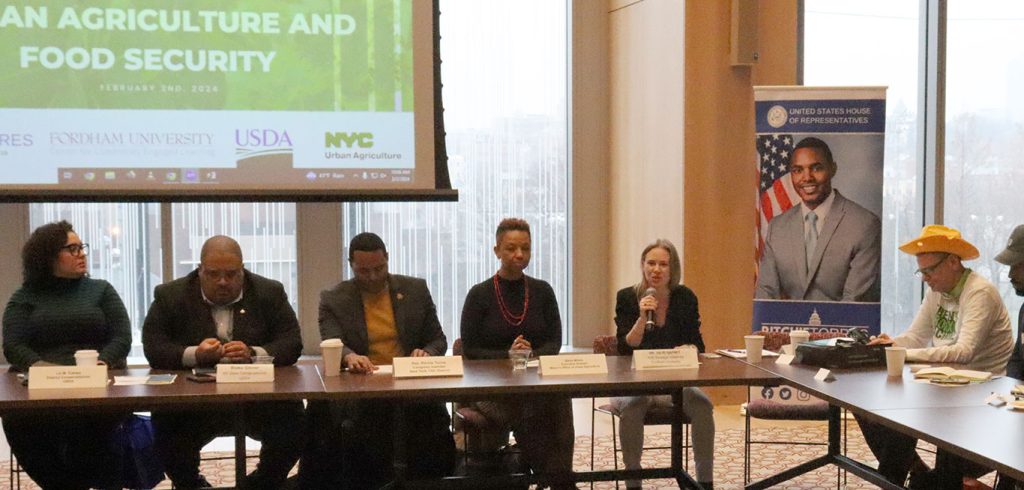
CCEL Director of Campus and Community Engagement Surey Miranda-Alarcon served as a panelist at a March 9 climate justice workshop at SOMOS 2024 in Albany, along with Mirtha Colon, GSS ’98, and Murad Awawdeh, PCS ’19.
Faculty News
David Gibson, director of the Center on Religion and Culture, and Julie Gafney, Ph.D., director of the Center for Community Engaged Learning, attended “Laudato Si’: Protecting Our Common Home, Building Our Common Church” conference at the University of San Diego on Feb. 22 and 23.
Marc Conte, Ph.D., professor of economics, and Steve Holler, Ph.D., associate professor of physics, presented their research around air quality, STEM education, and education outcomes on March 11 at the first night of Bronx Appreciation Week, which the Fordham Diversity Action Coalition organized.
Alumni
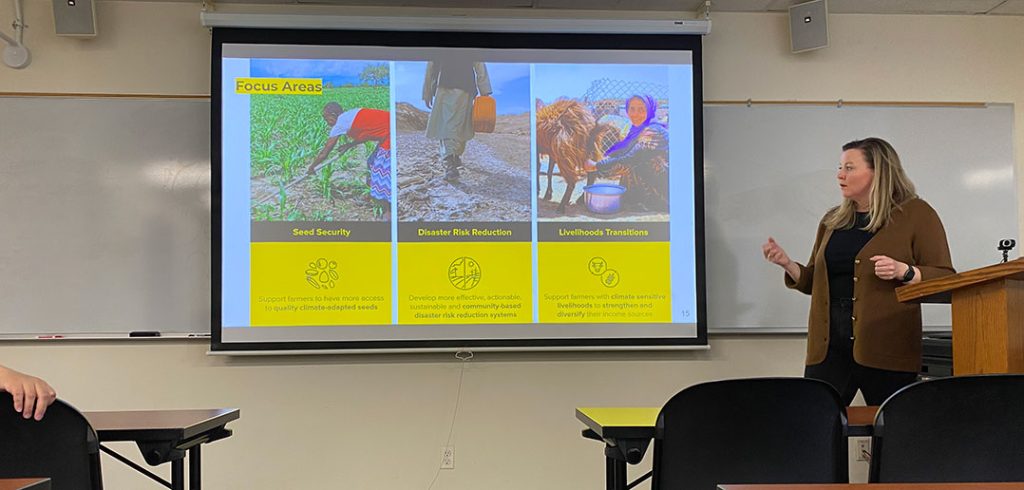
On March 14, Tara Clerkin, GSAS ’13, director of climate research and innovation at the International Rescue Committee, delivered a lecture at the Rose Hill campus titled “The Epicenter of Crisis: Climate and Conflict Driving Humanitarian Need and Displacement.”
In Case You Missed It
Here are some sustainability-related stories that you may have missed: In January, economics professor Marc Conte published the findings of a study that examined whether people living in areas with more air pollution suffer more from the coronavirus. The Gabelli School of Business partnered with Net Impact, a nonprofit organization for students and professionals interested in using business skills in support of social and environmental causes. A group of the Gabelli School Ignite Scholars traveled to the Carolina Textile District in Morgantown, North Carolina, to learn the benefits of sustainable and ethical manufacturing.
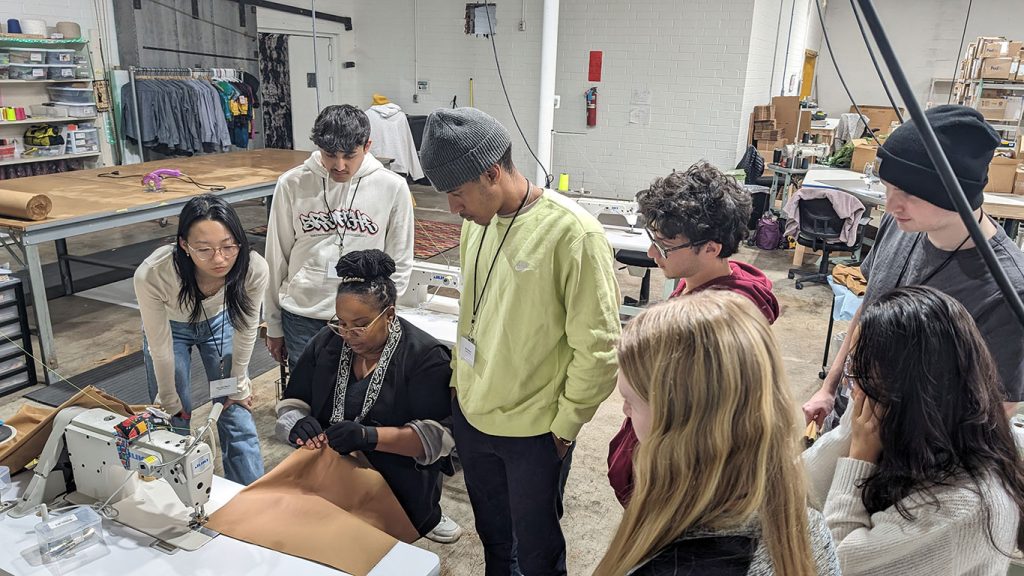
Upcoming Events
April 12 and 19
Poe Park Clean-up
In celebration of Earth Day on April 22, the Center for Community Engaged Learning is organizing visits to the park, where volunteers can help pull weeds and spread mulch. 10 a.m. – 2 p.m., 2640 Grand Concourse, the Bronx. Sign up here.
April 13
Bird Watching in Central Park
Law professor Howard Erichson will lead students on a birdwatching tour of Central Park, where they hope to spot and identify a few of the hundreds of species that pass through Fordham’s backyard on their annual migration routes. Meet at the Law School lobby at 9:30 a.m. Contact [email protected] to reserve a spot.
April 13
Ignatian Day of Service
Students and alumni will meet at the Lincoln Center campus and walk over to nearby Harborview Terrace, where they will build a community garden with residents. Lunch and a conversation about Ignatian leadership will follow. 10 a.m. – 2 p.m.
Click here to RSVP.
April 15
ASHRAE NY Climate Crisis Meeting
The theme of this meeting of the American Society of Heating, Refrigerating, and Air-Conditioning Engineers is “Challenge Accepted: Tackling the Climate Crisis.” All are welcome.
7 a.m.- 1 p.m., Lincoln Center Campus. Contact Nelida LaBate at [email protected] for more information or register here using code FordhamStudent2024.
We’d Love to Hear From You!
Do you have a sustainability-related event, development, or news item you’d like to share? Contact Patrick Verel at [email protected].
]]>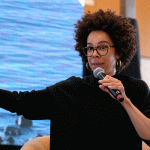
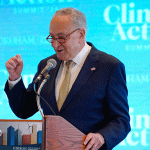
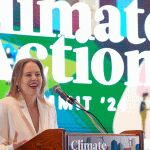
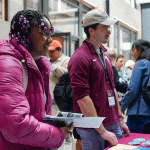
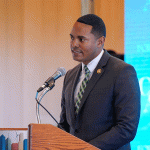
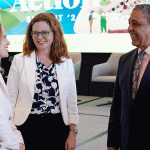
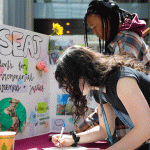
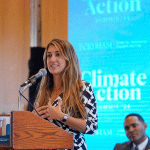
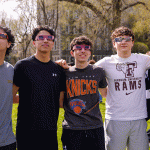
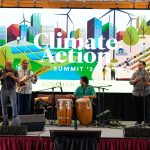
Daylong Event Calls for Grassroots Action and Celebrates Fordham’s Role as EPA Grantmaker
We don’t all have to be scientists to fight climate change, a prominent marine biologist and activist told Fordham students, activists, and members of the Bronx community at Fordham’s Rose Hill campus on April 8.
“I think what the world needs, right now more than ever, are people who can move between different disciplines,” said Ayana Elizabeth Johnson, Ph.D.
“We need people to solve climate problems in business, in engineering, in law, in medicine … all of these things relate to the world and how it’s changing. Everyone needs to know at some fundamental level what’s happening.”
Johnson, a marine biologist and co-founder of the group Urban Ocean Lab, was the keynote speaker of Fordham’s second annual Climate Action Summit. Her speech, on a day when millions of Americans paused to take in a rare solar eclipse, was a reflection of her personal journey and activism taken from her forthcoming book, What If We Get It Right? (Penguin Random House). She also sat for a Q&A session with H. Shellae Versey, Ph.D., an associate professor of psychology at Fordham.
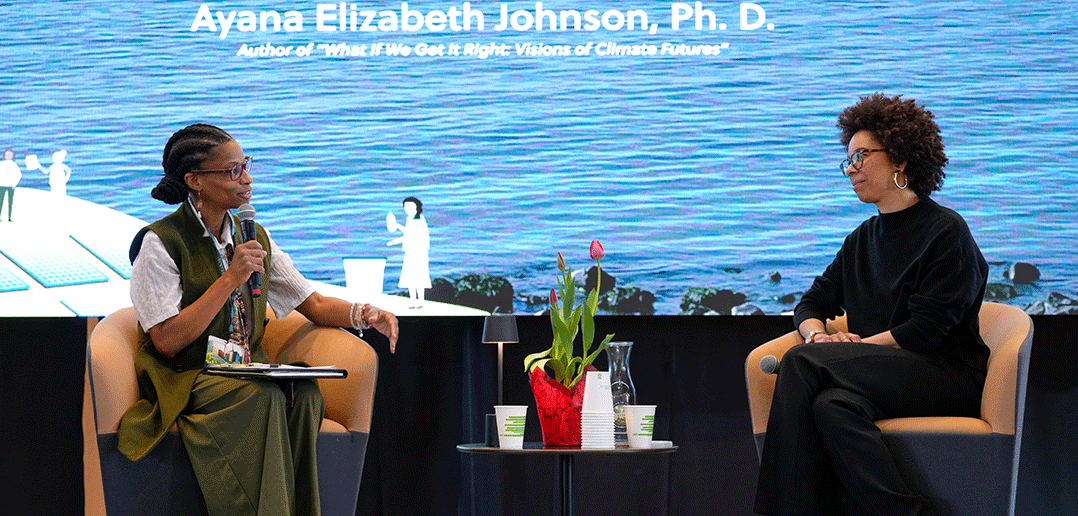
The work she’s done on behalf of communities from New York City to the Caribbean, she said, was always bolstered by a belief that anyone can be a part of the fight–including those who, like her father, were held back by racism, or those like her, “brimming with juxtapositions.”
“I’m a scientist who always intended to have a career in policy. I’m the daughter of a practical school teacher and a wistful artist. I’m cold New York winters and Caribbean heat,” she said.
“I’m working class and Harvard. I’m Black and white. I’m urban and smitten with the wilderness. I’m proof of the American dream—and proof that it is all too rare.”
The notion of taking a leadership role in fighting climate change was also the focus of other activities during the summit, which was organized by Fordham’s Center for Community Engaged Learning. An expo featured community groups, fireside chats, and panel discussions that examined federal funding for community-led solutions, as well as the future of environmental justice in higher education.
Elected Officials Celebrate Fordham’s Role as EPA Grantmaker
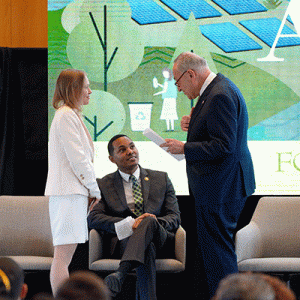
A morning press conference featured Senate Majority Leader Chuck Schumer and Congressman Ritchie Torres, who praised Fordham for taking on the responsibility of distributing $40 million EPA funds through a grant it was awarded in December. The grant, which will be administered by the Center for Community Engaged Learning, was the direct result of the Inflation Reduction Act (IRA), which was passed in 2022.
No Better Place
“We couldn’t have thought of a better place than Fordham to dispense this [funding]to go to grassroots groups,” said Schumer, who was instrumental in passing the IRA.
Torres added the program is benefiting the Bronx not by accident, but by design. “We designed the Inflation Reduction Act to lift up the lowest-income communities of color, especially the Bronx, which has been Ground Zero for environmental injustice,” he said.
The Bronx Is Not Burning; the Bronx Is Greening
“For a Bronx-based institution to receive $50 million in federal funding to distribute throughout the region is nothing short of staggering and unprecedented. And so, with the partnership of Fordham University, we are writing a new chapter in the story of the Bronx. The Bronx is not burning; the Bronx is greening.”
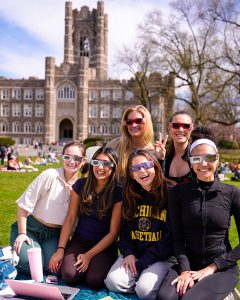
Also attending the celebration was U.S. Rep. Adriano Espaillat. Others who could not attend sent staff members, including Gov. Kathy Hochul, Sen. Kirsten Gillibrand, U.S. Rep. Paul Tonko, Bronx Borough President Vanessa Gibson, City Council Member Oswald Feliz, Westchester County Executive George Latimer, and Ulster County Executive Jen Metzger. See more elected official comments here.
Tania Tetlow, president of Fordham, said the grant, which will see the Center for Community Engaged Learning working with partner organizations from New York to Puerto Rico, epitomizes the mission of Fordham.
“This is so very us, this idea of connecting science with justice, of thinking about how we wake people up to the dangers ahead, and the chances to work together and inspire action and bring hope to an issue that can make us all despair and want to look away,” she said.
Julie Gafney, Ph.D., assistant vice president for strategic mission and executive director of the Center for Community Engaged Learning, thanked those responsible for the funding, community partners, and all those that will be involved in the project.
“Many of you are going to be partners in this work as we move ahead and really reorient Fordham around an initiative of public impact and social responsibility and see how traditional teaching, learning, and research can be leveraged in real-time toward community solutions.”
]]>Fordham will receive the funds over three years, working with partner organizations to help uplift disadvantaged and hard-to-reach communities as well as those disproportionately affected by climate change, pollution, and other environmental stressors. Fordham is one of just 11 institutions nationwide selected to manage $550 million in federal funds earmarked for the program.
“Fordham University stands for impact on the world and finding solutions to the most urgent problems,” said President Tania Tetlow. “Fordham combines cutting-edge research with a deep connection to community, building on 182 years of engagement with the Bronx and expanding outward across the globe. This project embodies Fordham’s mission. We believe in the power of community-driven solutions to climate change to capture the insights and ingenuity of the people on the front lines of global warming.”
Approximately $10 million of the award will be designated for the grantmaking operation and related programming, as well as for Fordham’s own research. Serving as the EPA Region 2 grantmaker for the project, called the 2023 Environmental Justice Thriving Communities Grantmaking Program, Fordham will allocate the remaining $40 million in subgrants ranging from $75,000 to $350,000 to foster various environmental justice initiatives. Fordham’s Center for Community Engaged Learning is leading the initiative, which will be directed by Julie Gafney, Ph.D., assistant vice president for strategic mission initiatives, and Surey Miranda, director of campus and community engagement.
Community and Academic Partners
The University is collaborating with key community and academic partners, including the New York Immigration Coalition, New Jersey Alliance for Immigrant Justice, ConPRmetidos in Puerto Rico, Community Foundation of the Virgin Islands, Business Initiative Corporation of New York, and several universities across the target regions. This collaborative approach will ensure a broader impact and integrate the University’s research and teaching with real-world environmental justice efforts.
Communities will be able to apply to Fordham for a subgrant to fund a range of different environmental project activities, including small local clean-ups, local emergency preparedness and disaster resiliency programs, environmental workforce development programs, air quality and asthma-related projects, healthy homes programs, and projects addressing illegal dumping.
The Fordham grantmaking initiative—called Flourishing in Community—will support each subgrant with a Community of Practice group that includes faculty, community leaders, and graduate assistants, ensuring comprehensive support and maximizing effectiveness.
“This grant is the direct product of Fordham’s commitment to center environmental justice and sustainability in our public impact teaching, learning, and research. In Fordham’s Flourishing in Community Grantmaker Initiative, we created a transformative approach that offers a new vision of higher education: one that values community impact alongside cutting-edge research,” said Gafney. “Our initiative not only provides grants to disadvantaged and disproportionately impacted communities but also extends to comprehensive wraparound support, ensuring the sustainability and impact of these crucial community-led projects.”
The grant also underlines Fordham’s commitment to STEM curricular development, as well as the University’s engagement with communities as they respond to the most pressing issues facing our city and our nation.
“We are grateful to have worked alongside our partners across EPA Region 2 to ensure accessibility to this much-needed funding for all,” said Miranda. “We aim to ensure that the most impacted communities can leverage the funding and technical assistance available through the program. This will help build their capacity and strengthen the work already taking place in New York, New Jersey, Puerto Rico, and the U.S. Virgin Islands.”
Lisa F. Garcia, EPA Region 2 administrator, said Fordham’s work with the agency “will be the start of a fruitful relationship that will build upon both EPA’s commitment to addressing climate injustice and Fordham’s promise of environmental stewardship.”
“As a grantmaker, Fordham University will help the EPA advance environmental justice in a direct way that will help to undo the past harms of environmental injustice,” Garcia said.
A ‘Transformative Opportunity’
Rafael Roger, president of Business Initiative Corporation of New York, one of Fordham’s partners, said the Flourishing in Community initiative is a chance to “begin addressing environmental issues that will improve the lives of millions of people.”
“This opportunity is transformative for our region and will bring justice to communities that have been marginalized,” he said. “While creating jobs and improving buildings is part of our mission, being able to add ‘improving the environment’ is a new benchmark.”
Amy Torres, executive director with the New Jersey Alliance for Immigrant Justice (NJAIJ), said that “too often, New Jersey is the punchline in jokes about pollution, contamination, or hazardous waste. But for New Jerseyans who bear the brunt of environmental racism or who have been displaced by climate crisis, it’s no laughing matter.”
“As the state’s largest immigration coalition, NJAIJ is proud to be a part of the collaborative effort under Flourishing in Community,” she said. “Together, we will uplift the voices of those most impacted in EPA Region 2—in particular climate refugees, agricultural workers, and people displaced or harmed by environmental racism.”
Dee Baecher-Brown, president of the Community Foundation of the Virgin Islands, said her organization is “honored” to be Fordham’s partner in this work.
“CFVI recognizes the significance and potential impact of this grant in advancing environmental justice and addressing the needs of overburdened communities, and is poised to employ our extensive experience and infrastructure to maximize the value of Flourishing in Community in the U.S. Virgin Islands,” Baecher-Brown said.
Also in the Caribbean, Isabel Rullán, co-founder and executive director of ConPRmetidos in Puerto Rico, said that she and her colleagues would bring their own grantmaking experience to bear and “prioritize supporting underrepresented groups focusing on eliminating barriers that limit organizational development.”
Murad Awawdeh, PCS ’19, executive director of the New York Immigration Coalition, said the organization is proud to partner with Fordham on its environmental justice efforts.
“This new funding from the EPA is an important first step in ensuring more community-based groups have the support they need to bring attention to and continue to alleviate the impacts of climate change, pollution, and other environmental stressors on immigrants, low-income communities, and people of color,” he said.
Those interested in learning more about the program—including how to apply for grants—can fill out this form.
For media inquiries, contact Jane Kidwell Martinez, Fordham’s director of media relations, at [email protected] or 347-992-1815.
]]>The highway, which was constructed in the 1950s and ’60s, has long been blamed for a host of poor health outcomes in the Bronx. In December 2022, New York City Mayor Eric Adams announced the creation of a study to reimagine the highway, including options such as rerouting it through a tunnel or building parks atop the sunken sections.
That study is being funded by a $2 million U.S. Department of Transportation grant created by the Infrastructure Investment and Jobs Act passed by Congress in 2021.
Giving Voice to Community Members
The Center for Community Engaged Learning was one of 10 community partners chosen to assist the DOT in gathering input from residents who live near the expressway. The center will use the funds to organize listening sessions and collaborate with other community groups, including Gambian Youth Organization, Casa Yurumein, and Bronx Health Link. The groups will work together to organize events and canvas the neighborhoods surrounding the highway.
Aiming to Reunite Neighborhoods
Julie Gafney, director of the Center for Community Engaged Learning, said she hopes the efforts will help reunify neighborhoods that were destroyed when homes of approximately 40,000 residents were demolished to make room for the highway.
“One of the big issues with the Cross Bronx Expressway and other major roadways in the Bronx is it cut people off from access to services, to fresh fruits and vegetables, to public transportation,” she said.
“So we want to make sure that whatever solution we’re looking at is going to unite communities, provide resources to them, and doesn’t inadvertently replicate some of these errors from the past.”
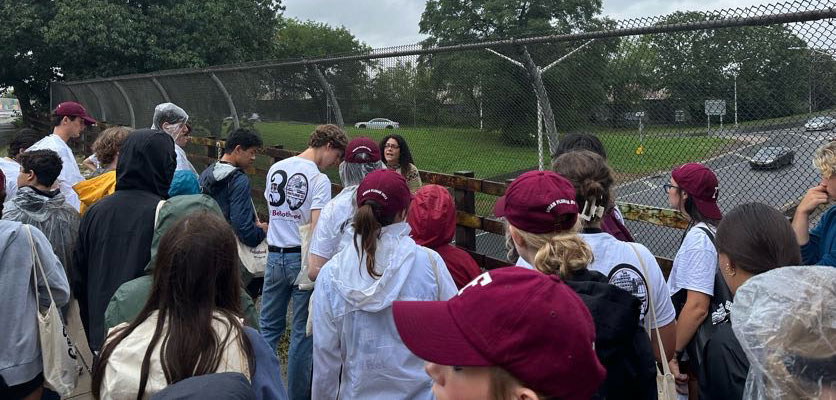
Opportunities for Students
The Cross Bronx Expressway has been a major focus of the center’s recent efforts in the Bronx. Last month, 350 students who participated in Fordham’s annual Urban Plunge toured sections of the highway to learn about its impact. Gafney said members of the Fordham community are continuing to enroll in these “walkshops.” She envisions multiple opportunities for students to get involved in areas such as design, visual arts, architecture, and smart city planning.
“I would love to see as many members of the Fordham community working as possible with us to facilitate those conversations,” she said.
“We’ll be doing everything from canvassing and door-knocking to holding small conversations over coffee with groups of neighbors to hear about how the Cross Bronx is currently affecting them and their communities and what they would like to see. The best ideas, I’m sure, are going to come from the folks who are most impacted by the issue.”
]]>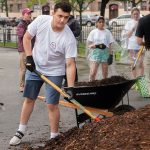
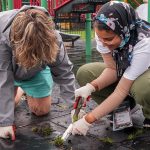
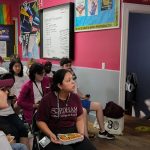
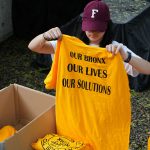
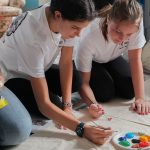
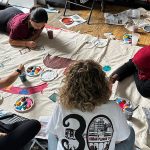
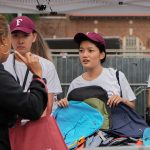
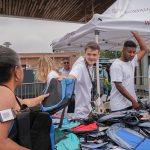
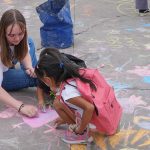

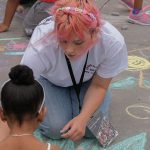
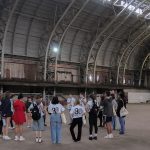
Nearly 250 first-year students fanned out across the Bronx on Aug. 25 as part of Fordham’s Urban Plunge – an annual pre-orientation program that gives new students the chance to explore the city’s diverse neighborhoods through a lens of community, diversity, and engagement.
Students helped serve lunch to those in need at POTS—Part of the Solution, revitalized Poe Park, painted banners for one of the Northwest Bronx Community and Clergy Coalition, and did clean-up work at the community garden Drew Gardens.
A Back to School Festival that debuted last year at Fordham Plaza was also staffed by Urban Plunge students. In keeping with the philosophy that the weekend is also an opportunity for learning about their new home, students spent the morning before their service activities visiting other sites around the Bronx. In addition to tours of the Kingsbridge Armory, St. Barnabas Hospital, and the Bronx River Alliance, students visited areas along the Cross Bronx Expressway, where they learned about the highway’s impact on residents.
Urban Plunge at Fordham celebrated its 30th anniversary this year. Julie Gaffney, director of Fordham’s Center for Community Engaged Learning, which runs the program, said it’s driven by the needs of the Bronx community. That’s why health and environmental justice issues are front and center, she said.
“We really want to introduce first-year students, along with their upper-class mentors, to what’s driving community work in the Bronx right now,” she said.
“It’s an ideal ground for fostering a four-year commitment to community solution building here in the Bronx.”
Urban Plunge continued Saturday with lectures such as “What Does Engagement Look Like at Fordham.”

A Landmark with Untapped Potential
Mehak Wadhwa, a native of Richmond Hill, Queens, who is starting her first year studying physics/engineering, was one of the students who toured the Kingsbridge Armory, a decommissioned site with 100-foot ceilings less than a mile from the Rose Hill campus.
The tour was conducted by a representative from the New York City Economic Development Corporation, which is responsible for the site. Wadhwa found it interesting to learn about the multiple plans for the armory that have come and gone over the years and how the future of the site is still up in the air.
“I know Manhattan, Queens, and the other boroughs, but I’ve never really gone to the Bronx. I thought Urban Plunge was a nice way to get involved in the community,” she said.
She also got to ask the Economic Development Corporation rep how any plans for the armory’s redevelopment would affect the surrounding community.
“My mother is also a small business homeowner. I’ve been reading a lot about gentrification, and as a person of color, I know how it specifically impacts them,” she said.
A Park With Literary History
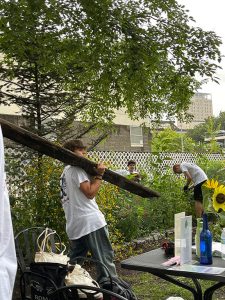
A block away, Christian Sibel, a first-year student from Collegeville, Pennsylvania, ferried wheelbarrows of fertilizer to tree pits around Poe Park, where poet Edgar Allen Poe lived in a cottage from 1846 to 1849.
Sibel, who is planning to major in International Political Economy, said the opportunity to do service work influenced his decision to attend Fordham.
“Fordham seems to be doing their best to work with the community in the Bronx, and I’m really just excited to be a part of that for the next four years. It’s exciting to explore a community different from my own,” he said. “Last night, I went out for a walk. The area is beautiful; the architecture of these buildings is incredible.”
Learning About Bronx Renewal and Advocacy
Sophie Ritz, a first-year student at the Gabelli School of Business from Westwood, Massachusetts, was one of roughly 30 students who visited the Northwest Bronx Community & Clergy Coalition on East 196 Street for several hours. There, she and her fellow “plungers” painted banners, did gardening and learned how the group, which was instrumental in the renewal of the borough during the 1970s, has now taken a lead in the push for the equitable development of the Kingsbridge Armory.
“I didn’t know we’d learn quite as much as we did. I was surprised at how hard it was for the people to do what they wanted with the armory,” she said.
“Maybe naively, I kind of figured that it’s in their community; they’d be able to do more of what they wanted with it.”
Back to School
The Back-to-School Festival brought next to 40 different community organizations to the Fordham Plaza, where a DJ spun tunes and students handed out school supplies and backpacks.
This year also featured tents across Fordham Road at Rose Hill Park. Sinhawe Haji, a native of Ethiopia who grew up in Washington D.C., was one of several students there giving away school supplies and helping children find things like trees with heart-shaped leaves as part of a scavenger hunt organized by the New York City Parks Department.
“It’s been so good,” she said. It’s sweet, seeing the smiles on their faces not only when they get the school supplies but also when they find whatever object in nature they’re looking for.”
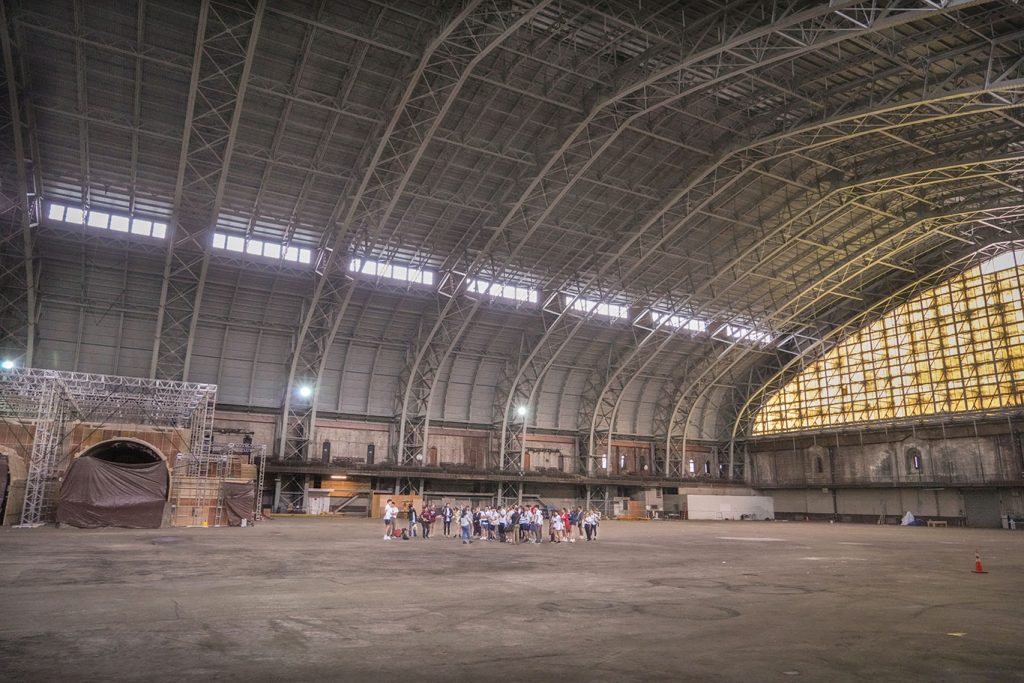
— Photos by Rebecca Rosen, MacKenzie Brown, Emma Elsdon, Bridget Flanagan, Marai Rodriguez and Christina Ou.
]]>Photos by Adam BermudezFordham received a $25,000 AARP Community Challenge grant in June to significantly expand the Highbridge La Familia Verde Market in the Bronx. The University launched the market last year in partnership with several community organizations; Fordham undergraduates and other student volunteers help staff it throughout the summer and fall.
The grant is part of a nationwide AARP Livable Communities initiative, which strives to help communities become great places to live for residents of all ages.
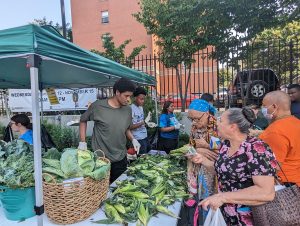
Kicking Off Another Season of Fresh Produce
Fordham’s Center for Community Engaged Learning (CCEL), which oversees the market, kicked off a second season of the weekly market on July 12 with a ribbon-cutting ceremony presided over by Bronx Borough President Vanessa Gibson.
Fresh produce supplied by two local farms and a community garden in the Bronx was available for purchase under the market’s large tent.
Jennifer Benitez, a 33-year-old Highbridge resident who lives a short walk from the market, which is located in the parking lot of a senior living facility in the South Bronx, came to shop for herself, her husband, and their 18-month-old child. She visited the market every week last year, and was there this Wednesday for watermelon, carrots, lettuce, and cilantro, the latter of which she was especially excited to get fresh.
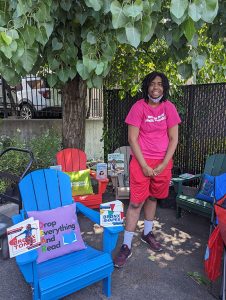
A native of the Dominican Republic, she joked that she uses cilantro in “pretty much everything.”
“The food from this market is a lot fresher, it has better flavor, and for me, I find it to be better because it’s organic,” she said in Spanish.
“I found the whole market to be beautiful and interesting, especially because a lot of elderly folks in the area enjoy it.”
Expanding Beyond Produce
The market’s expanded footprint features a seating area, a reading nook, and an area for cooking demonstrations. The first cooking demonstration featured local chef Geneva Wilson, who showed visitors how to roast beets.
Cookbooks Made by Fordham Students
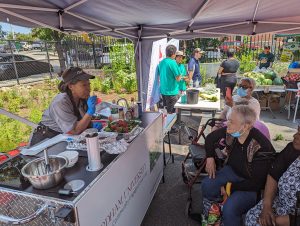
The grant also funded the printing of cookbooks that are distributed for free at the market. The book was created by Fordham students in The Anthropology of Food, an undergraduate class taught in the spring by Julie Kleinman, Ph.D., associate professor of anthropology.
Students interviewed community members and sourced local recipes to create a cookbook with recipes that are both meaningful to the community and create awareness about the produce available at the market.
Supported by the Center for Community Engaged Learning, the course was a continuation of the market’s academic component. The idea for the market itself was partly conceived last year in the course Ecology and Economics of Food Systems.
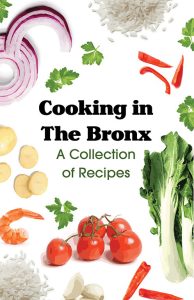
Intergenerational Community Building
Surey I. Miranda, director of campus and community engagement at CCEL, said the goal of the market, which will run from 10 a.m. to 3 p.m. every Wednesday until mid-November, is to create a neighborhood space that encourages intergenerational community building.
“We want to meet people where they’re at. We want to make sure that they’re not only getting their fresh produce, but they’re able to be connected with key services,” she said.
“So there are going to be different organizations connecting people to their places, so they don’t have to go out of their communities to receive essential services.”
The market’s community co-sponsors include Bestcare, Inc., Essen Health, BridgeBuilders, The Mary Mitchel Family and Youth Center, The Bronx is Reading, Highbridge Community Development Corporation, 1199SEIU, and Catholic Charities Community Services.
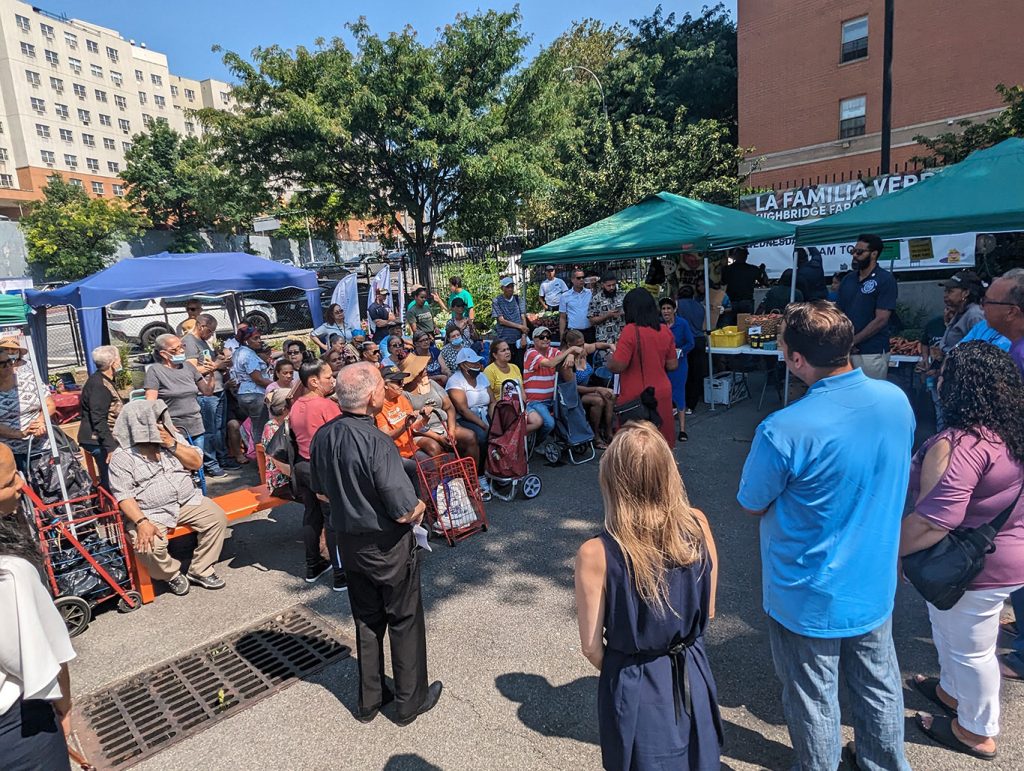
]]>
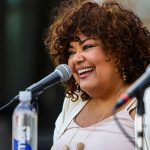
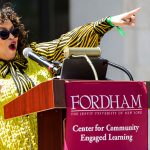
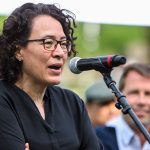
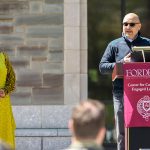
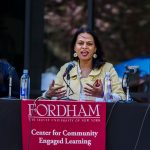
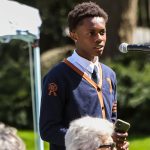
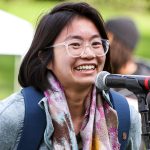
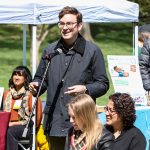
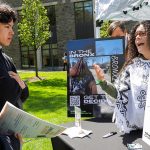
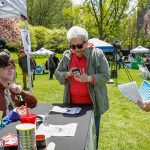
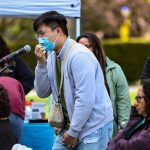
Fordham marked the launch of a seven-year transformative climate change plan with an April 19 event at the Rose Hill campus that brought students, activists, government officials, and neighborhood leaders together on the Rose Hill campus.
The University also welcomed back to campus Elizabeth Yeampierre, FCRH ‘80, who laid out the challenges of achieving climate justice in a keynote address
“In the climate justice movement where I come from, we say that transition is inevitable, but justice is not,” she said.
Yeampierre, an attorney who co-chairs the national Climate Justice Alliance and is the executive director of the Brooklyn-based Latino community organization UPROSE, challenged institutions such as Fordham to shake off conventional thinking.
“Climate change is not conventional. It is unpredictable, it is violent, and it is here,” she said.
“We really need people who are thinking in a way that is unconventional and honors Mother Earth, and are building just relationships and are engaged in self-transformation, so that we are able to hold this work, which is literally the human rights of our day.”
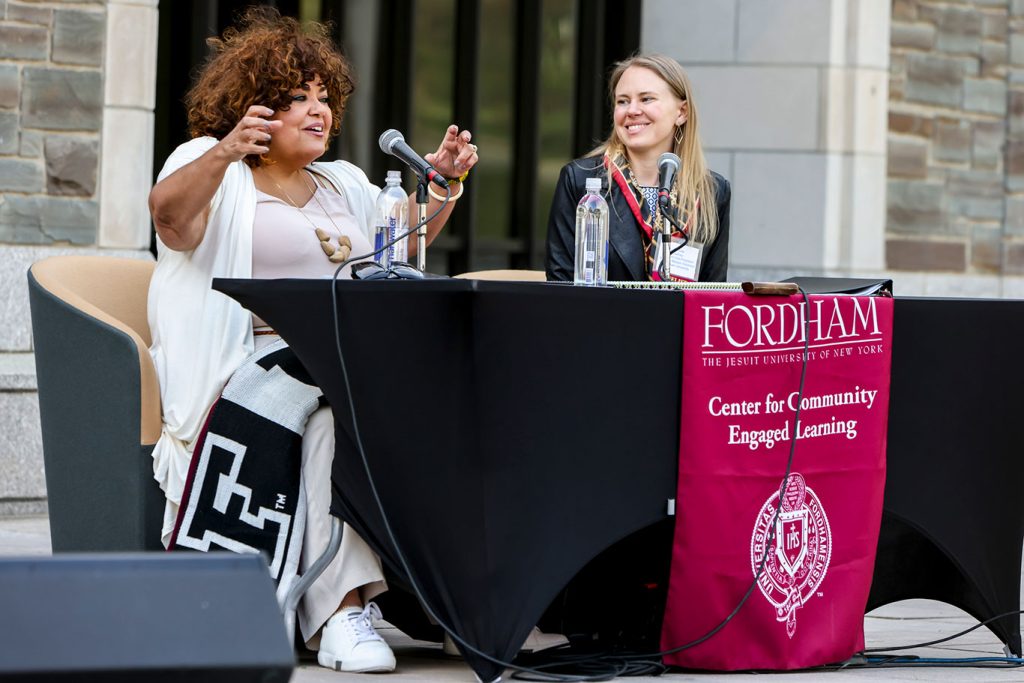
In a wide-ranging conversation with Julie Gafney, Ph.D., director of the Center for Community Engaged Learning (CCEL), on the terrace of the Walsh Family Library, Yeampierre laid out a case for a bottom-up strategy for dealing with climate change.
“We need to be able to listen to the people on the ground. The educated person knows how to take the formal education that they have, break it down, and make it accessible so that people on the ground can run with it,” she said.
As an example, she pointed to an app that UPROSE created for the 90 auto salvage yards in Sunset Park, Brooklyn, to use to access best practices for becoming climate adaptable. It includes information on chemicals that are vulnerable to extreme heat, which is expected to become a bigger problem in the future.
“Environmentalists would like to shut them down, but these are working-class people in our community, and we don’t throw away our people,” she said.
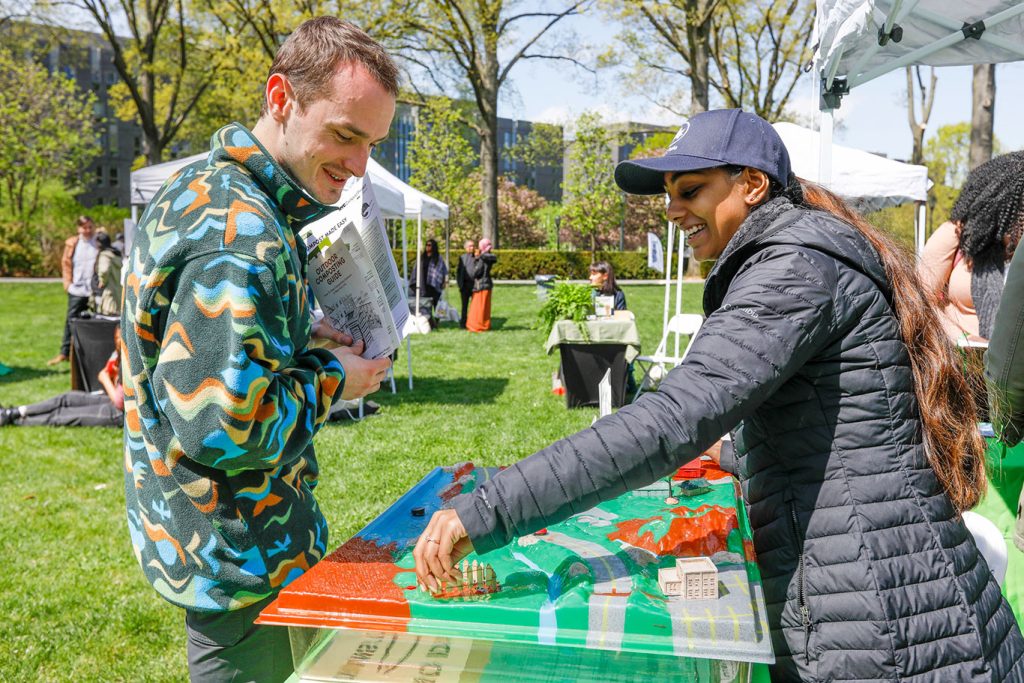
Ryan Chen, a junior environmental science major at Fordham College at Lincoln Center and a student advocacy fellow, was one of a dozen members of the audience who engaged with Yeampierre in a Q&A session. He plans to apply the lessons from her talk to his work with Sunrise Movement NYC.
“Sunrise NYC is developing local campaigns to fight for a new green deal that also addresses the needs of people in New York City,” he said.
“What Elizabeth told me is, it’s more important to support the work of other organizations that are already doing. That’s something that I really want to bring to the conversation, to make sure that we don’t co-opt other people’s work.”
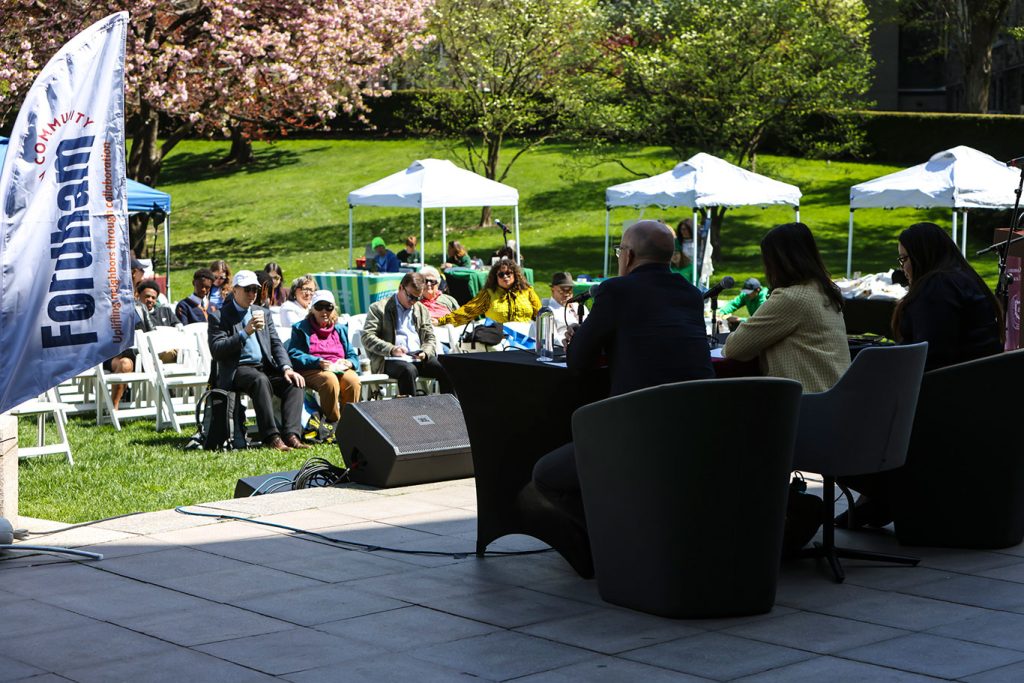
The theme of grassroots organization suffused the day’s event, which was organized by CCEL. Tents arrayed on the lawn in front of the library featured representatives from groups such as the Bronx River Alliance, Cafeteria Culture, and Friends of Pelham Bay Park, and speakers included representatives from Loving the Bronx and the New York City Parks.
A panel discussion, “Global Migration, Climate Displacement, and Racial Justice,” featured Annetta Seecharran, GSAS ’94, executive director of Chhaya CDC, an advocacy group that serves South Asian and Indo-Carribbean communities, and Andrew Rasmussen, Ph.D., professor of psychology and head of the Culture, Migration, and Community Research Group at Fordham.
Seecharran, a graduate of Fordham’s International Political and Economic Development (IPED) program, noted that her organization’s clients don’t often bring up climate change as a concern, but they do bring up health and housing problems that are exacerbated by it.
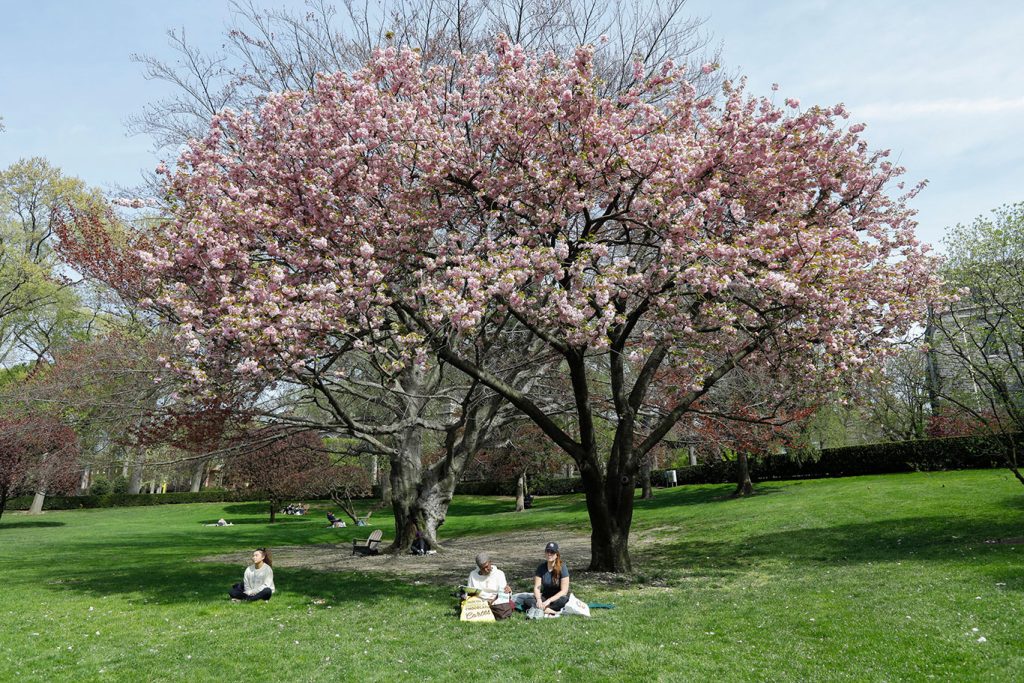
Hurricane Ida, which caused extensive flooding in New York City in 2021, and killed 11 people trapped in basement apartments, was a wake-up call that housing and weather issues can collide, even inland.
“My organization is known for working on tenant and homeowner issues. We’re not known as an environmental organization, but we can’t think of our work as separate from the environmental,” she said.
Rasmussen said community organizations need to organize and document environmental issues that are displacing them, and demand help from local officials.
“Those of you who know your Frederick Douglass remember that power concedes nothing without demand. It never has, it never will. Community organizations are the key to making those demands.”
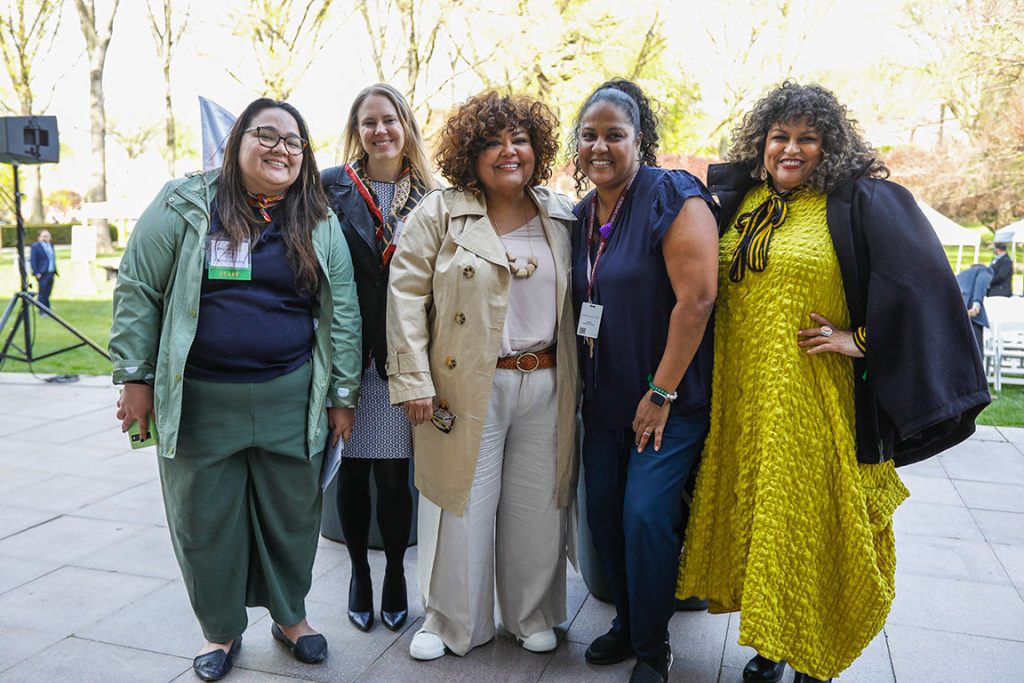
]]>
The program is designed to fill in a gap left by New York City’s Summer Youth Employment Program (SYEP), which provides paid work experience to New Yorkers aged 14 to 24. Beyond Rising focuses on youth who may not feel comfortable filling out SYEP’s rigorous paperwork, said Julie Gafney, Executive Director of the CCEL, and offers them positions in offices across the Fordham Rose Hill campus.
A Population That’s Left Out
The SYEP program helps thousands of youth with work experience, but it doesn’t work for all the city’s youth, said Tomas Ramos, founder of the Oyate Group—a nonprofit that aims to lift up underserved communities across New York City.
“There’s a population that is being left out—and that’s the undocumented population,” he said.
It’s a need that’s grown over the last few years as record numbers of immigrants enter the country, Gafney said. Recently, the New York Times published an extensive investigation into widespread, systemic exploitation of unaccompanied minors who cross the border looking for work or a new life. The investigation found that across the U.S., minors work long hours in factories, construction, and meat plants, and often end up injured or dropping out of school.
“This is one of the most pressing issues facing our nation, migration justice, and especially making sure that there are really, really good pathways that avoid any form of exploitation,” Gafney said.
Paid Internships—with Fordham Students as Mentors
This year, Beyond Rising will offer 30 paid internships to high school students, between the ages of 16 and 18, who live in the Bronx, Harlem, or Washington Heights; over the six-week program, students will be paid a weekly stipend of $500, delivered as a prepaid debit card.
For the program, bilingual Fordham students act as mentors to support interns, assist in English language learning, engage them in campus and cultural activities, and foster a sense of belonging on a college campus.
During last year’s pilot Beyond Rising program, roughly 20 interns all from the Dominican Republic, worked in jobs across campus, including in athletics, the Dean’s office, and the CCEL. Typically, their families came to the U.S. looking for better economic opportunities. With Beyond Rising, interns could both contribute to family living expenses and learn what it feels like to be on a college campus. Since interning, several of them have been accepted into NYC colleges.
Putting College Within Reach
For many high school students, especially immigrants, attending college is hard to imagine. Beyond Rising aims to demystify the experience, show students about college life and the fun and connections they can make outside of classes, and offer students some tools to pursue college themselves, if they wish.
“It’s setting their gears… on each of those kids, saying that there’s more to pursuing higher education, it’s more than just an education, you’re learning constantly outside from the classroom,” said Fordham student Melvin Martinez, who mentored Beyond Rising students last year.
As the Campus Ministry office’s best Spanish speaker, Martinez helped orient and train the office’s two interns. For Martinez, an Engineering Physics major at Fordham College at Rose Hill, watching the interns learn the ropes of the office and then complete tasks on their own was incredibly gratifying, he said.
“It was awesome; I think the fact that we spoke Spanish made us grow tight-knit, even to this day, I still reach out to the kids every now and then. But it’s something special, something that I would definitely do again, and they really enjoyed it as well,” Martinez said.
Martinez grew up on Valentine Street, a short walk from Fordham’s Rose Hill Campus. Now studying at Fordham, he’s particularly interested in how the university interacts with its community, one of the CCEL’s primary functions, and is helping the center explore how to expand resources for marginalized community members.
“I do believe that there’s a lot of kids that don’t feel motivated in pursuing their education; I’ve seen it myself growing up around here, too,” Martinez said. “There’s just no support, and then when you have no motivation, and no support, well, it’s like, ‘what’s the point?’”
Students who’ve interned with Fordham through Beyond Rising can apply to Fordham for free and will receive college planning help. Additionally, working with the CCEL, the university has committed to meeting 100% of the financial need for admitted students from a number of local schools, aiming to make college a more financially feasible option for students in the community, including Beyond Rising interns.
Martinez, Ramos, and Gafney all hope the program can be expanded and implemented or copied throughout the city and even the country. Already this year, the Oyate group is helping Lehman College run a similar program, Ramos said. But he wants to see it grow to be year-round and duplicated at colleges across the city’s five boroughs.
“[We need programs] that prepare young people who have just joined the community here in the U.S. for viable pathways where they can build wealth, they can gain the education that they’re looking for, and build a sustainable and thriving life,” Gafney said.
–by Meredith Lawrence
]]>Photo by Patrick VerelWe hear regularly about how climate change is impacting the weather. What’s perhaps less obvious is that it is also affecting the food we eat.
In 2015, the U.S. Department of Agriculture warned in a report that the progress that has been made on global food security is likely to take a hit because of climate change. Rising temperatures, the report said, are expected to cause “local availability limitations, price increases, interrupted transport conduits, and diminished food safety.”
That’s why, on a chilly Wednesday morning in October, Fordham student Julio Farach-Varona found himself working at a farmers’ market in the parking lot of a senior living facility in the South Bronx.
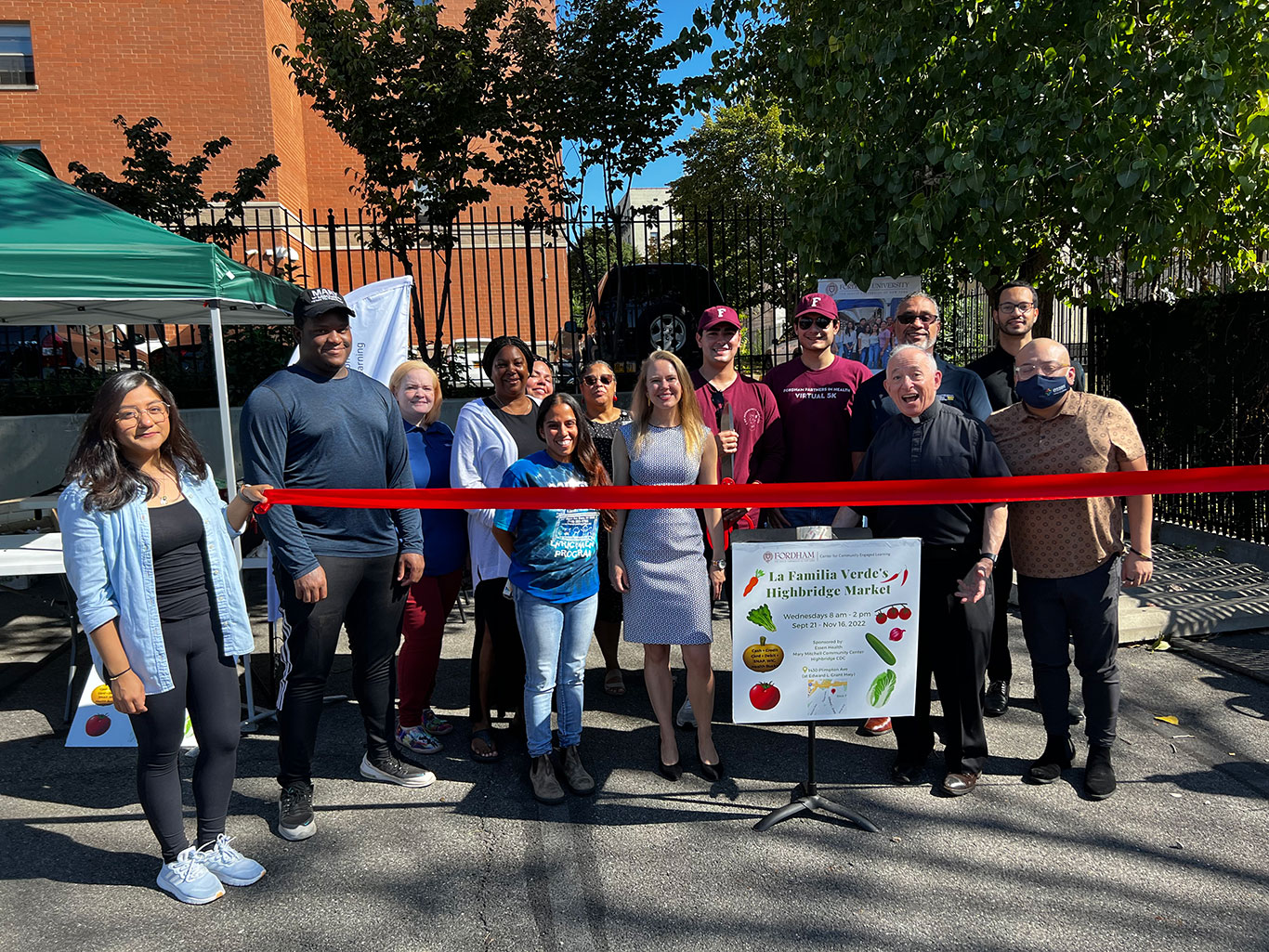
Photo by Adam Bermudez
Classwork on the Streets of the Bronx
Farach-Varona, a senior at Fordham College at Rose Hill who is from Atlanta, is one of 16 students enrolled in Ecology and Economics of Food Systems. The brand-new course is co-taught by Dawn Fariello, Ph.D., lecturer in biology, and Andrew Simons, Ph.D., associate professor of economics.
Farach-Varona’s job that morning, along with four other undergraduates, was to help transform a parking lot in Highbridge, a neighborhood just south of the Cross Bronx Expressway, into a distribution hub for fresh, affordably priced produce. Students cleaned and sorted produce from three upstate farms, helped customers, and tidied up at the conclusion of the market, which ran for five hours a week for six weeks this fall.
At the market, and another one students worked at in East Tremont run by La Familia Verde, residents use government-issued Supplemental Nutrition Assistance Program (SNAP) and Farmers Market Nutrition Program coupons to make purchases, and because they’re supporting local producers, whose shorter travel times make their carbon footprints smaller, they’re helping in a small way to fight climate change.
“It’s kind of cool to see how you can apply what you’re learning in a classroom to the real world outside the gates of Fordham,” said Farach-Varona.
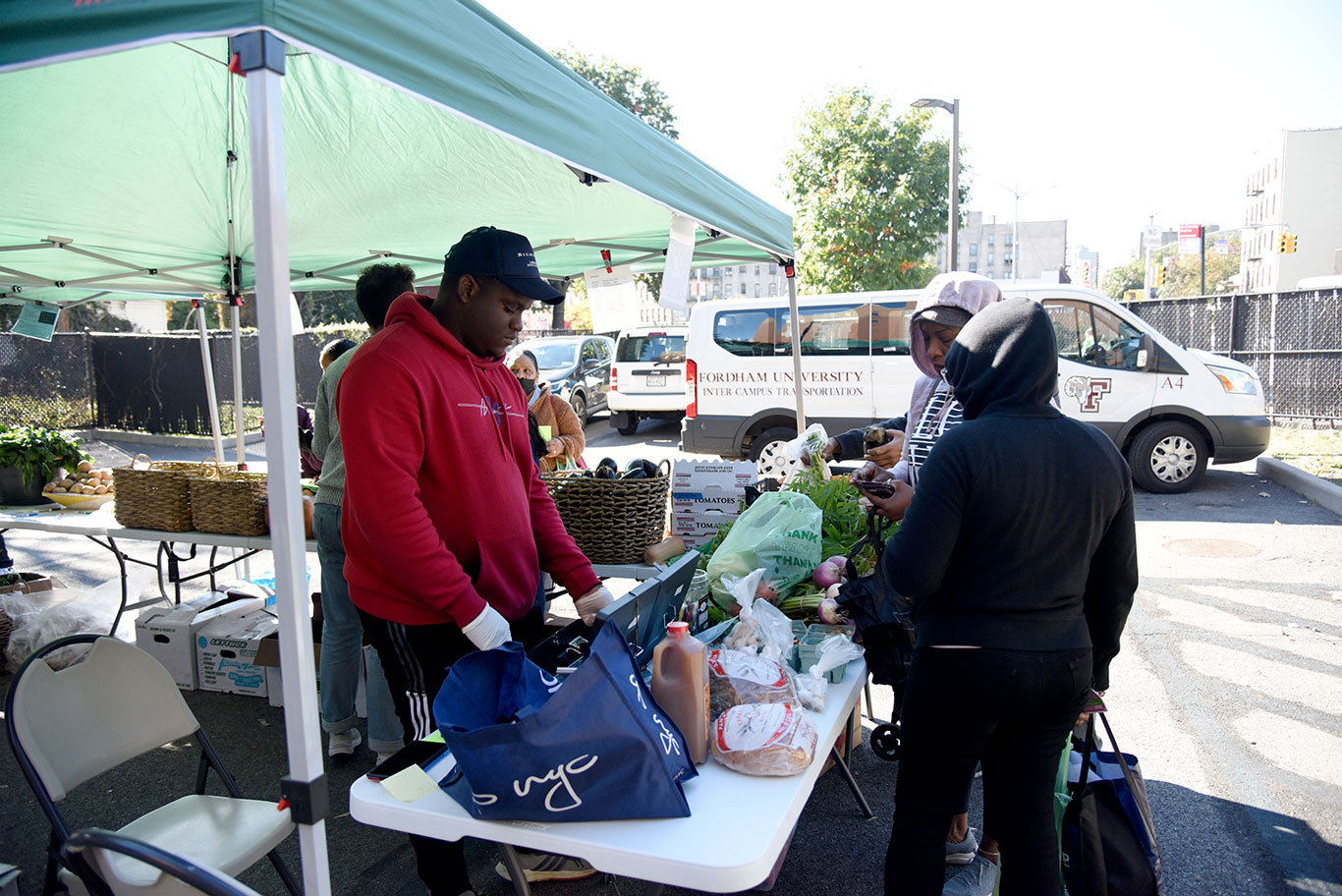
It was exactly the kind of outside-the-classroom experience he hoped to get when he toured the economics department his senior year in high school. His interest is in developmental economics, which is focused on the greater good for the greatest number of people, so the course piqued his interest. In addition to the community experience, students read Charles Mann’s The Wizard and the Prophet (Knopf, 2018), which gave them an understanding of food systems as a whole.
Addressing Climate Change: A Directive from the Pope
The class is a small part of Fordham’s larger efforts to address the effects of climate change. This February, in response to a call from Pope Francis, the offices of mission integration and ministry, the provost, and facilities management came together and tasked CCEL with responding to Laudato Si’ Action, a call that the Vatican issued as a follow-up to Pope Francis’ 2015 encyclical on climate change titled Laudato Si’.
After convening a task force for six months, the center published its Laudato Si’ Action Plan, joining 67 other universities around the world in doing so. The document is a seven-year plan with goals that touch on everything from hosting an annual sustainability conference and conducting a comprehensive study of waste management on campus to establishing a sustainability panel at Fordham’s International Conference on Cyber Security.
Complementing the Climate-Action Efforts of the Facilities Department
Fordham has also answered the call to reduce its carbon footprint in terms of its facilities. In 2007, the University was a founding signatory to the NYC Carbon Challenge, initially committing to reducing its greenhouse gas emissions by 30% over the next decade. Fordham extended its commitment to the challenge in 2017 by pledging a 40% reduction by 2030, and every year, progress, such as the 2019 installment of solar panels on the Rose Hill parking garage, is detailed in a climate action plan annual report.
Julie Gafney, Ph.D., director of the Center for Community Engaged Learning, said that the goals of Fordham’s Laudato Si’ plan are meant to complement and broaden the scope of continuous work done under the supervision of Marco Valera, vice president for facilities, to improve Fordham’s physical plant.
“We’ll be working really closely together on the ongoing infrastructure and facilities work, but we know that the work of sustainability goes beyond that,” she said.
“We’re an institution of higher education, so we need to look at how we’re teaching classes, the research projects that faculty are taking on, and our relationship with community partners, industry partners, and elected officials.”
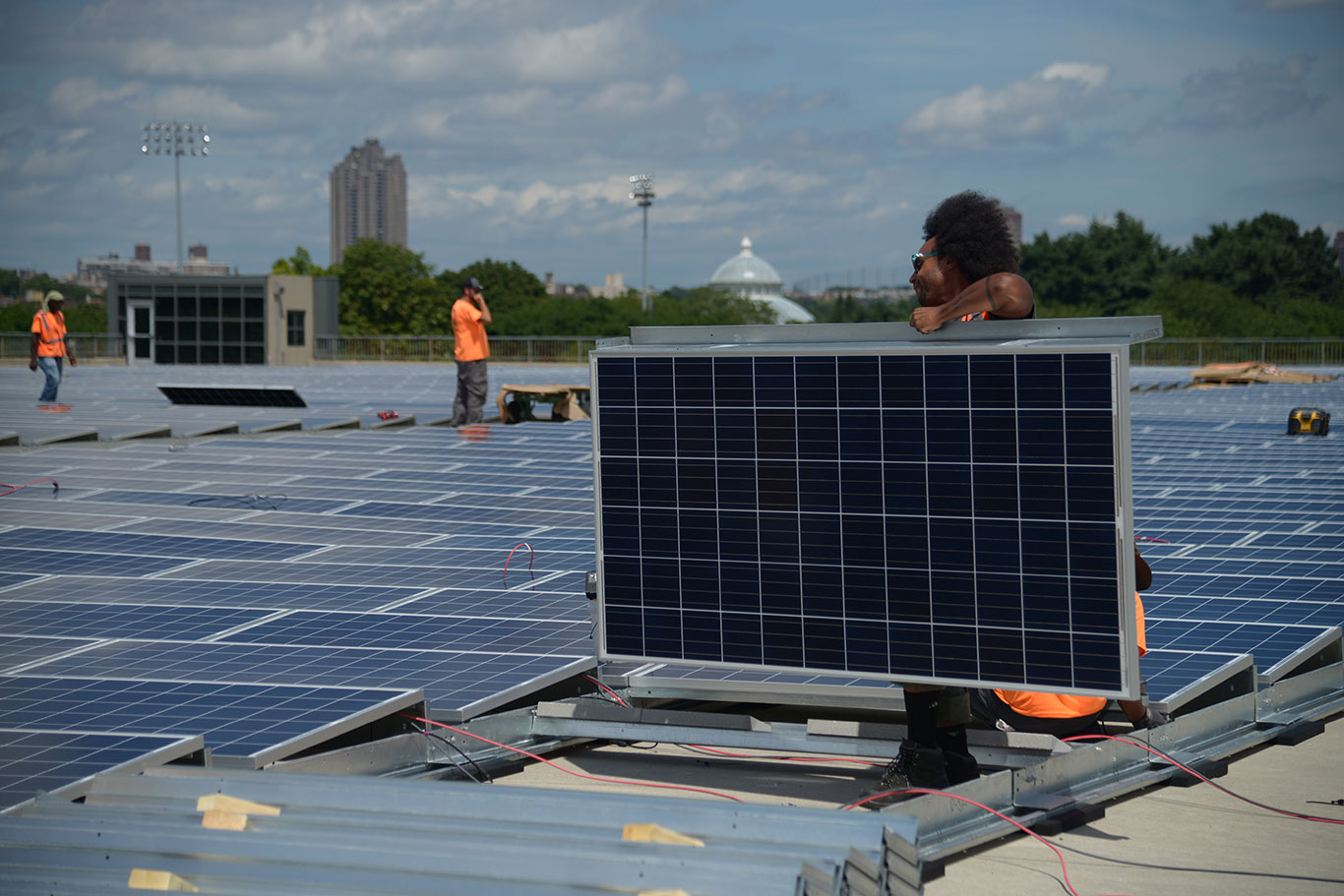
Different Perspectives on Food Systems
Fariello created the Ecology and Economics of Food Systems course last May after Fordham’s provost put out a request for an interdisciplinary STEM course with a Center for Community Engaged Learning (CCEL) connection. CCEL-related courses, which have community service built into the syllabus, have grown dramatically in number at Fordham since the first seven debuted in 2014; there are 90 this year. The course emphasizes food insecurity in the first half, and sustainability in the second. With a $1,500, five-year grant from CCEL, they were also able to make the connection to the market. Like the students in the course, both Fariello and Simons each have their own experiences with food; Fariello grew up with food insecurity, and Simons worked from 2008 to 2011 as director of programs for the aid organization Food for the Hungry in Addas Ababa, Ethiopia.
“I find that when students come to Fordham, they come from different demographics and show a very varied understanding of food systems,” Fariello said.
“So, it’s really important that when we’re talking about food systems and social, economic, and environmental sustainability, students get to see that. It’s not just learning it, but physically interacting with those sorts of differences.”
The food insecurity section required students to work 15 hours at the farmer’s market. The sustainability section featured a trip to Stone Barns, a non-profit farm and educational center in Pocantico Hills, New York, that has showcased sustainable food production practices since 2003. The two extremes are important to understand, as climate change is expected to exacerbate the divide in the future.
“You’re going to get a very different view of the people they see coming to the farmers’ markets in the Bronx versus the people they see at Stone Barns, which is very much on the elite, high end of the culinary scene,” said Simons.
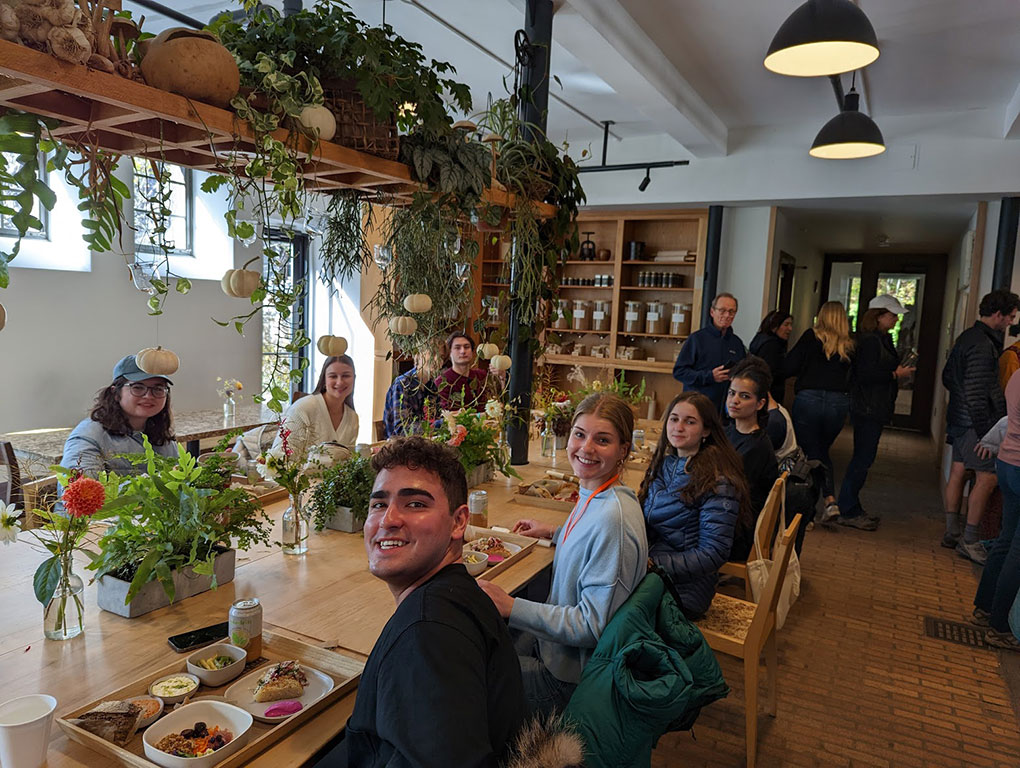
Photo by Dawn Fariello
The Complexities of Natural Resources Management
Fariello and Simons note that while there is a debate currently raging about whether it’s possible to both feed every person on the planet while also doing it sustainably, their goal is not to take sides but to help students better understand the contours of the complex challenge. If you want to increase food production, you can do so by cutting down forests and converting them to farmland. But then you remove a vital ally in the fight to slow climate change, as trees store carbon.
“Students are very worried about sustainability. They’re worried in some sense that the world is ending because of climate change,” said Simons.
“So they’re very interested to hear things like, ‘If you set up farming this way, you’re going take more land away from forests. What if technology can change, and get more yield per unit of land, then you wouldn’t necessarily need to take out a forest?”
Working with the Community
CCEL is a good place to oversee a wildly ambitious project, both because it is part of Fordham’s Department of Mission Integration and Ministry and because the center can connect the University to outside partners.
“We can’t do climate justice and environmental justice alone. We’re part of an ecosystem here in New York, nationally, and internationally,” she said.
The Ecology and Economics of Food Systems course is a great example of the kind of synergistic approach that CCEL is striving for, she said. The market in East Tremont has been open for over a decade, but the one in Highbridge is brand new, and opening it required collaboration between the La Familia Verde, the Mary Mitchell Family and Youth Center, Fordham, the Highbridge Community Development Corporation, Essen Health, and Catholic Charities. At Fordham, a great deal of the coordination was overseen by Surey Miranda-Alarcon, director of campus and community engagement at CCEL.
“Not one of these organizations could have done this on their own, and truly, we couldn’t have done it without the capacity that the students add,” said Gafney.
“One of the things I love about this project is, it is ongoing and sustainable. It’s not something we’re doing just for the learning value, although it does have tremendous learning value.”
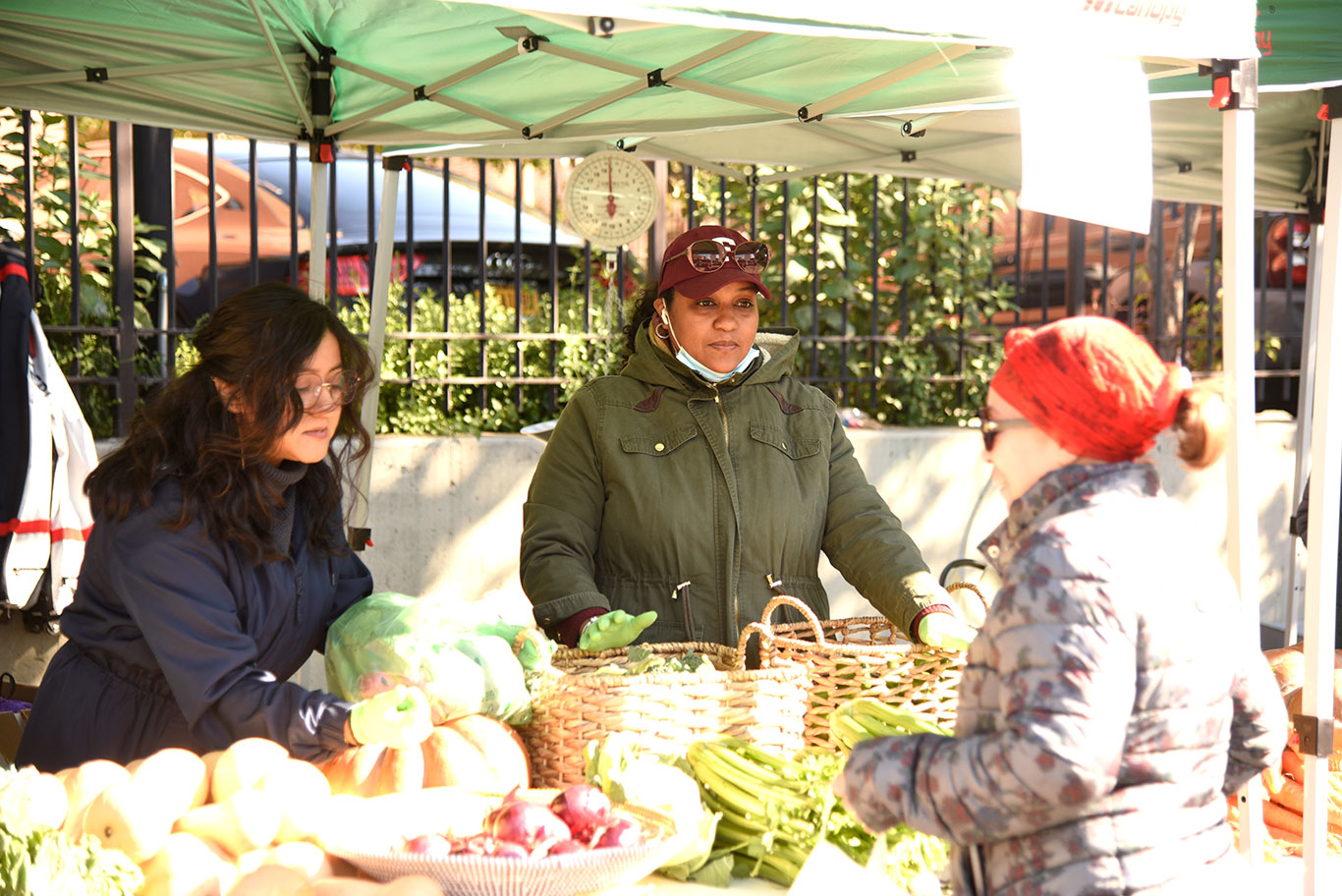
Photo by Patrick Verel
Aleyna Rodriguez, executive director of the Mary Mitchell Family and Youth Center, said the market fulfills two essential goals. One is bringing healthy food to those who either can’t afford it or can’t easily travel the hilly neighborhood of Highbridge to get it. The other is supporting the farmers at Rottkamps, Trinity, and Rising Roots, the upstate farms where the produce is grown.
“We try to keep everything affordable for community members, but when we hear from someone that something is marked too high, we do provide them with insight on the importance of supporting local farmers,” she said.
“We say to them, ‘You’re helping to feed their families as well. They’re helping to feed your family, and you’re helping to feed themselves.’ It’s a full circle.”
Rodriguez was effusive in her praise for the Fordham students.
“Even if they don’t speak Spanish, they’re able to connect with the community residents; they’re happy to see them,” she said. “And the community can see that Fordham is here.”
For Rafael Melgarejo, 82, a native of the Dominican Republic who has lived with his wife in Highbridge for 17 years, and in the Mary Mitchell Houses for the last three, his visit to the farmer’s market on Oct. 19 was his third. He was as excited to see his neighbors as he was to buy vegetables.
“There’s not too many chemicals in it. You grow it, and it’s healthier. The main thing is the will that you people have to help others, the needy ones,” he said of all the community groups involved. “That’s the main thing. For that, may God bless you.”
Farach-Varona likewise appreciated the sense of community that morning. His mother hails from Puerto Rico, so he grew up speaking Spanish. He found himself chatting with the mostly elderly customers about which vegetables would go well in sofrito—a mix of aromatics that is the base of many Latin American dishes.
“It was nice to talk to people on a deeper level rather than, ‘How many pumpkins do you want, or how many apples do you want?’” he said.
“It’s kind of the equivalent of working out. You just feel nice about it afterward, because you’ve interacted with so many people, and you see the smile on people’s faces when they get the produce, and they know it’s good food.”
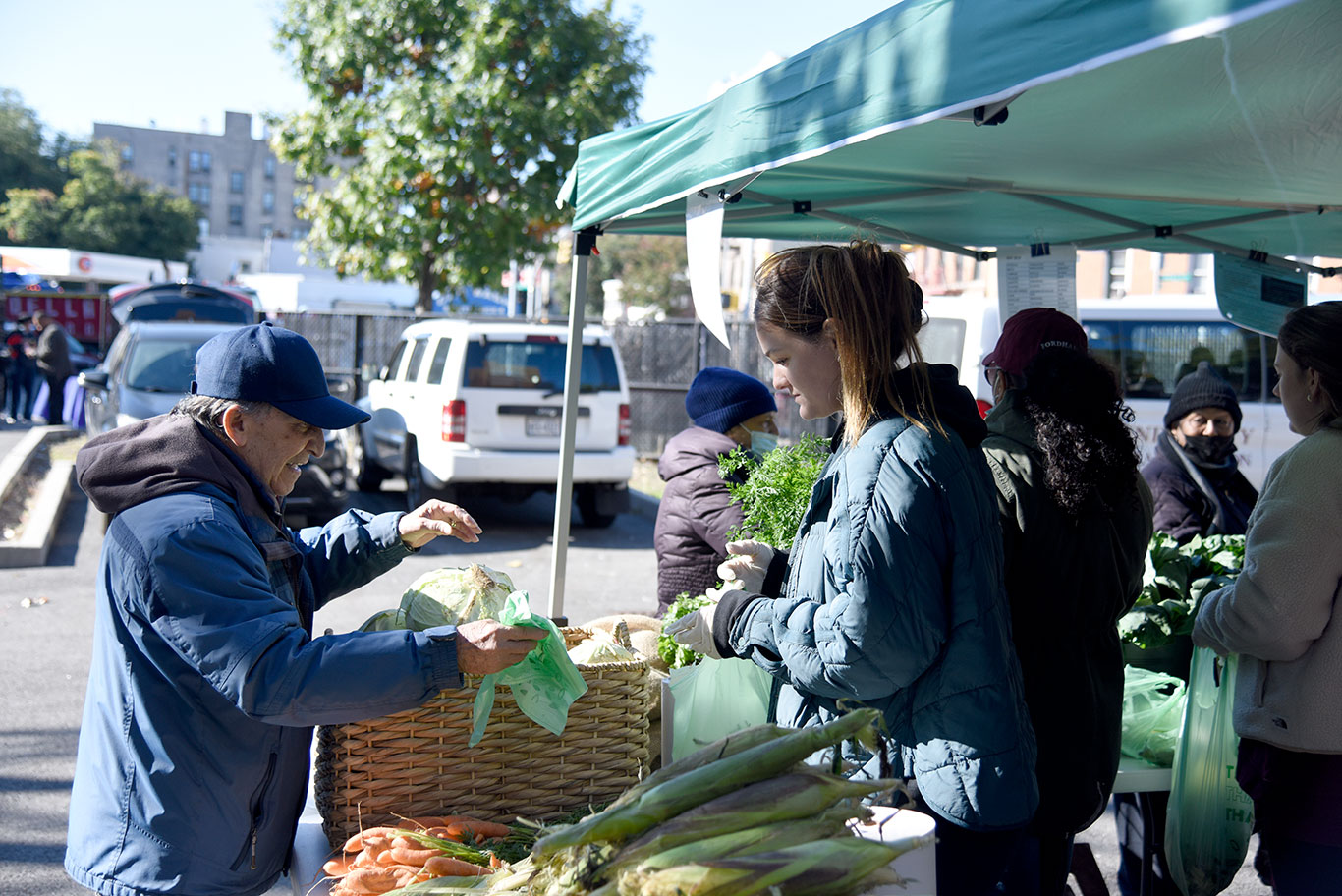
Photo by Patrick Verel
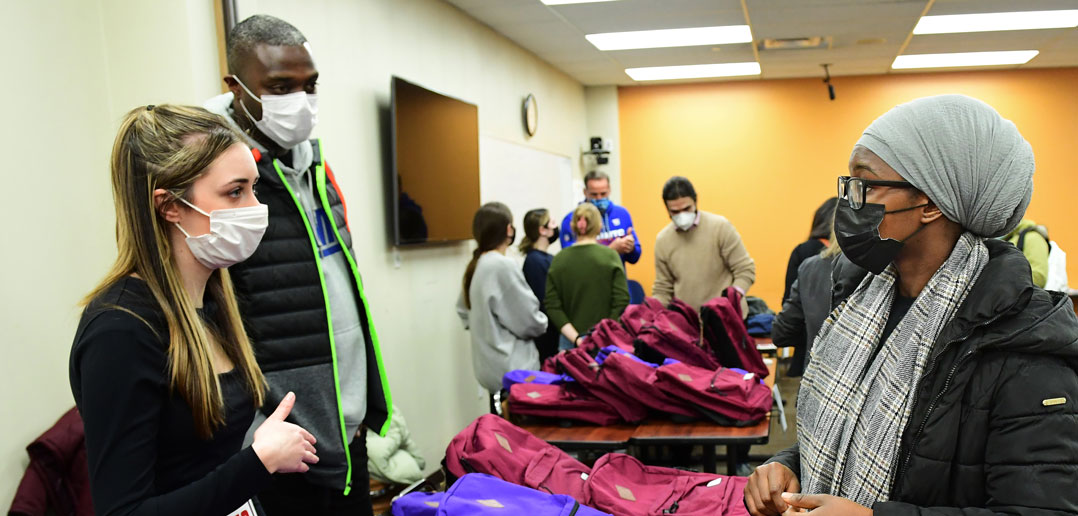
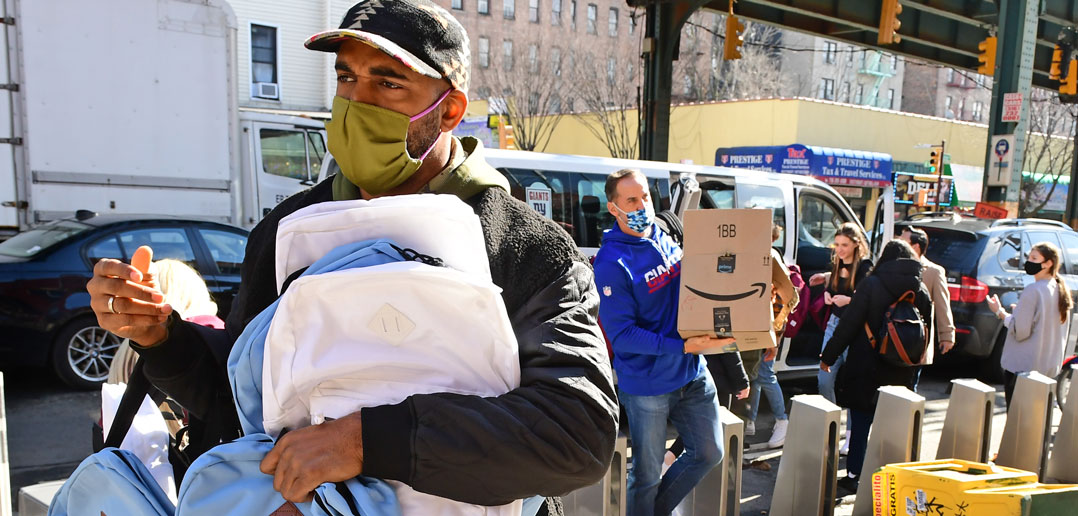
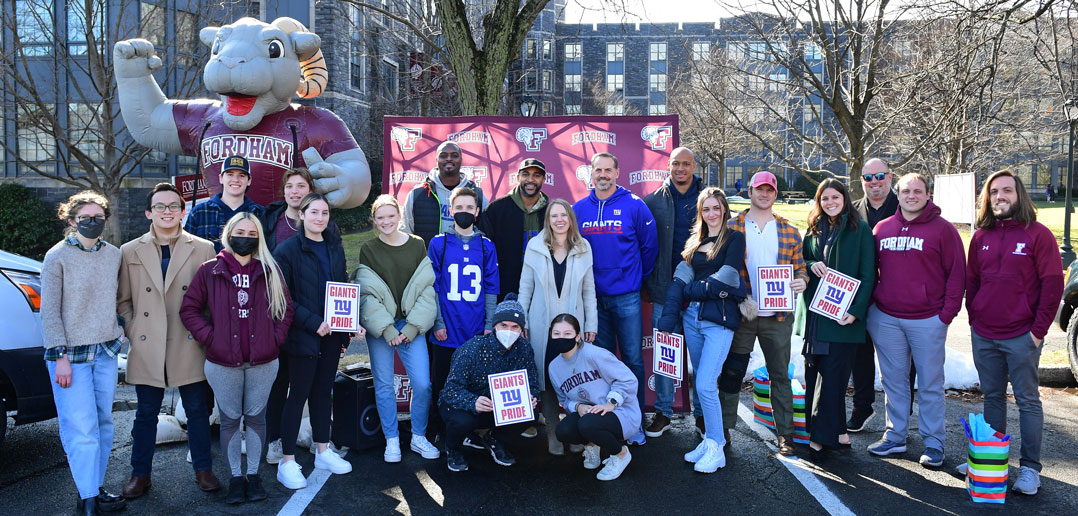
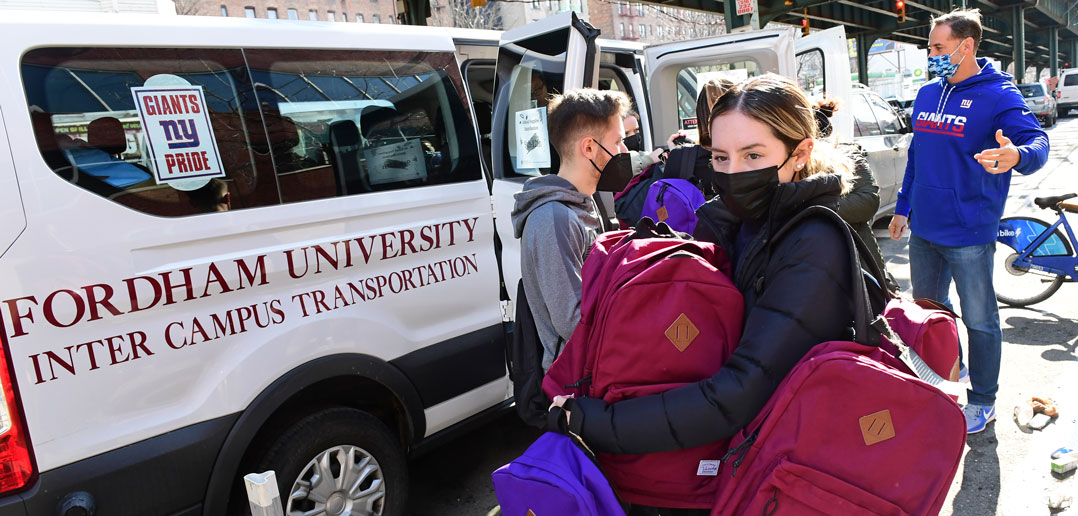
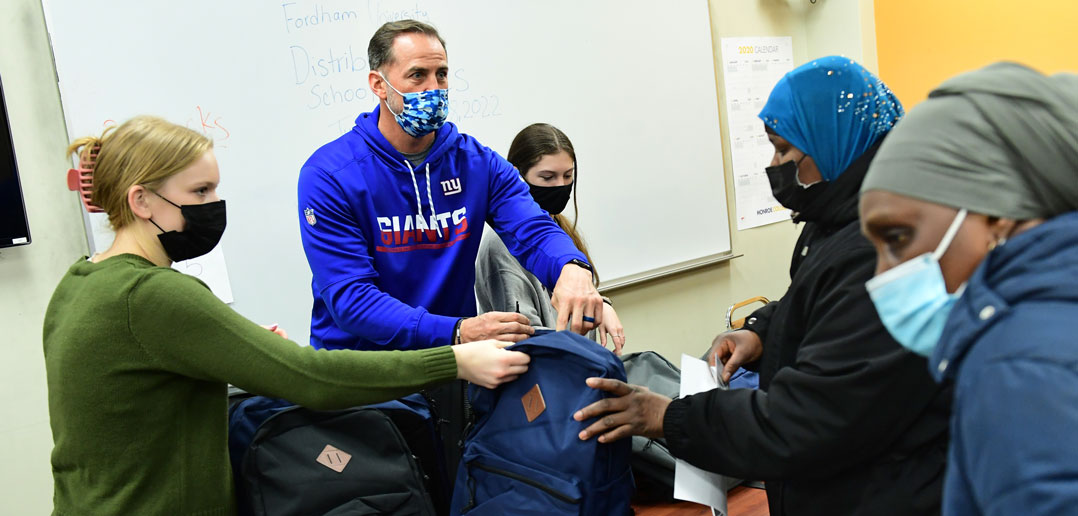 “A ray of sunshine.” That was how Chanasia Hunter described a supply and resource distribution event on Feb. 8, organized by Fordham University, Monroe College, and their partners—the New York Giants, BronxWorks, the Bronx Zoo, and others.
“A ray of sunshine.” That was how Chanasia Hunter described a supply and resource distribution event on Feb. 8, organized by Fordham University, Monroe College, and their partners—the New York Giants, BronxWorks, the Bronx Zoo, and others.
Hunter and her family were impacted by the devastating Bronx fire that ravaged an East 181st Street apartment building on Jan. 9, killing 17 residents and injuring many others.
“For a long time we were feeling ignored, so this is a ray of sunshine, and we appreciate y’all a lot,” she said.
Four members of the New York Giants—Shaun O’Hara, Plaxico Burress, Kerry Wynn, and David Tyree—joined members of the Fordham community in distributing backpacks filled with toys, education supplies, tablets with internet access, and other items for families who had been impacted by the fire. The event was geared particularly toward the residents who were not property owners in the building and therefore hadn’t benefitted from other events meant to help the victims, according to Julie Gafney, executive director of Fordham’s Center for Community Engaged Learning.
Gafney said that the goal of the center is to help build a bridge between Fordham and its neighboring communities and create ways to work together—something that is extremely necessary in a time of crisis.
“This responsibility is particularly clear to us when any of our neighbors encounters or faces a tragic or traumatic event, like our neighbors over on 181st Street in Tremont, who suffered the effects of the devastating fire last month,” she said.
A ‘Giant’ Effort
Since 2019, Fordham and the New York Giants have been engaged in a partnership that provides academic programming, internships, marketing opportunities, and joint community service efforts that support both Fordham students and the neighboring communities.
O’Hara said that he and the other Giants were glad to give back to their New York community and make sure the fire victims knew there were people looking our for them.
“I think we all feel like it was a privilege to play in the NFL and certainly to play for the New York Giants, and one of those privileges that I think you appreciate is the community,” he said. “Today is just a great opportunity to give back to our surrounding communities and let them know that we care about them. And anytime you see community members in need—we’re going to go assist them. We want them to know that they’re not in this alone.”
Kweesam Wood, who lived in the building that caught fire, said that he was grateful for the participating organizations and the Giants players for being there.
“A lot of us think that nobody cared about us, so to see something like this—to see people come out, for the New York Giants to come out, it was very good to see,” he said.
Students Glad for Chance to Help
Fordham’s Center for Community Engaged Learning gathered backpack items for students who were affected by the fire in grades kindergarten through 12th grade. Fordham students volunteered to help stuff the bags at Rose Hill and distribute them at Monroe College–which has served as a temporary emergency response center for families impacted by the fire.
“When this happens, it’s not their fault and they lose so much,” said Kamila Carpio, a junior at Fordham College at Lincoln Center. “We just want to give back whatever we can for the people who can’t afford [these items]. It’s nice doing things like this.”
John Navarra, a first-year student at Fordham College at Rose Hill, said that when he saw an email about CCEL needing volunteers, he knew he wanted to help his community.
“I’m from the area and I know what happened with the fire so I thought it’d be a good opportunity,” he said.
Dael Ki, a first-year student from Fordham College at Lincoln Center, said that she was glad the students and the University as a whole could give back.
“If something like this happened to me or anyone that I knew—I would hope that the community would do the same for us,” Ki said. “I think it’s important as a school in general to give back to the overall community.”
For transfer student Kyle Rohrs, the event was an opportunity to fully immerse himself in his new Bronx home.
“It’s amazing to help out in the community that I recently moved into along with the school that I recently transferred to,” he said. “I think it’s extremely important to be there to help people who unfortunately have had to go through something as tragic as what happened here.”
Support from an Alumna
Joy Tolliver, FCRH ’04, and the vice president of governmental affairs for Monroe College, said she felt a responsibility to help these grieving families.
“As an attorney, as a higher education professional, I’m very passionate about helping the communities that are in need—I’m very passionate about making sure that underrepresented populations have access to the resources that they need to be successful,” said Tolliver, who helped coordinate the effort. “In this situation we have families who are in the midst of grief and the very least that we can do is provide them with materials and supplies.”
Tolliver said that being able to work with both Fordham and her current job was the “realization of a dream”—one that she hopes she’ll get to realize again.
“I look forward to many future partnerships with my alma mater and bridging my current work with all the great work that’s happening at Fordham,” she said.
]]>The annual event recognizes alumni volunteers and helps further the FUAA’s mission to foster lifelong connections among alumni and promote a sense of general goodwill and support for Fordham worldwide.
Sally Benner, FCRH ’84, chair of the FUAA Advisory Board, introduced new and returning board members, 24 volunteers who represent the University’s 200,000-plus global alumni worldwide. They include graduates from 10 Fordham schools, including Marymount and Thomas More College, and their class years span six decades. Quoting another graduate, Benner said the group aims “to serve as connective tissue—to connect us to each other, to connect you to the University, and to connect the University to you.”
As she spoke about the Fordham community and its commitment to cura personalis, or care for the whole person, Benner noted that the alumni were gathering during a week in which “the world commemorates the birthday of Martin Luther King Jr.”—and less than two weeks after a fire killed 17 people and injured dozens of others in the Tremont neighborhood of the Bronx, a mere 15-minute walk from the Rose Hill campus.
She shared how she is motivated by a quote from King’s 1963 “Letter from Birmingham Jail”: “’We are caught in an inescapable network of mutuality, tied in a single garment of destiny. Whatever affects one directly affects us all indirectly,’” she said, quoting King. “Tonight, I ask our alumni community to consider care for the whole person to include care for our communities.”
Benner encouraged alumni to seek out Julie Gafney, Ph.D., executive director of the University’s Center for Community Engaged Learning, who was in attendance with a list, now posted on the center’s Instagram account, of how victims of the fire felt the Fordham community could offer support.
“If you have the means to share your abundance, by contributing your skills or good fortune to help, you will learn how the largely Gambian community would value it most,” Benner said.
A Legacy of Transformation
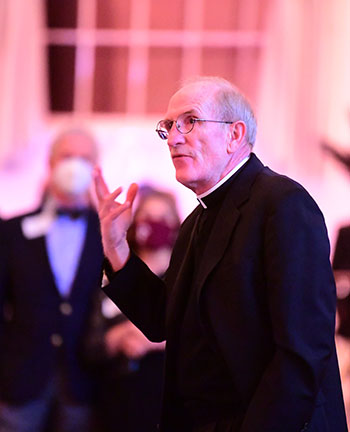
This year’s FUAA reception also marked the last one for Joseph M. McShane, S.J., before he steps down as president of Fordham in June. Throughout the evening, on a big screen behind the ballroom stage, the FUAA featured a slideshow highlighting the University’s transformation under his leadership since 2003. Prior to the event, attendees had an opportunity to submit their own personal tributes and memorable McShane moments, which were included in the slideshow.
During his own speech, Father McShane thanked Benner, who stepped into her role as chair just this year, for “organizing us this evening and doing it with her characteristic class.”
He also remarked on the University’s strength as it continues to navigate the pandemic, noting that the Class of 2025 is “the largest, most diverse, and brightest class in Fordham’s 180-year history,” and that 2021 was the “best fundraising year” in the University’s history, thanks to the “extraordinary generosity” of alumni and others who invested more than $84 million in the University and its mission.
“We didn’t just get through,” he said. “Fordham came through with great strength because it was true to its sense of mission, and its mission and its heart is a mission that is based on love and directed toward the cultivation of all the gifts that students have—cura personalis, in other words.”
The FUAA is always looking to connect with new voices from the University’s alumni community. For info on its upcoming events or to learn more, visit Forever Fordham.
]]>